
Cochrane family plot of Hugh Taylor's family at Linton cemetery from 1863 to 1923.

Headstone of Hugh Taylor Cochrane, his wife Catherine Cochrane nee Baird, son Oswald Albert and daughter baby Laura Jane, buried in their family plot at Linton Cemetery in Victoria.

This time was before many rural Victorian Postal deliveries began - Hugh had to pick up all his mail from the Ballarat Post Office back in Feb 1857.
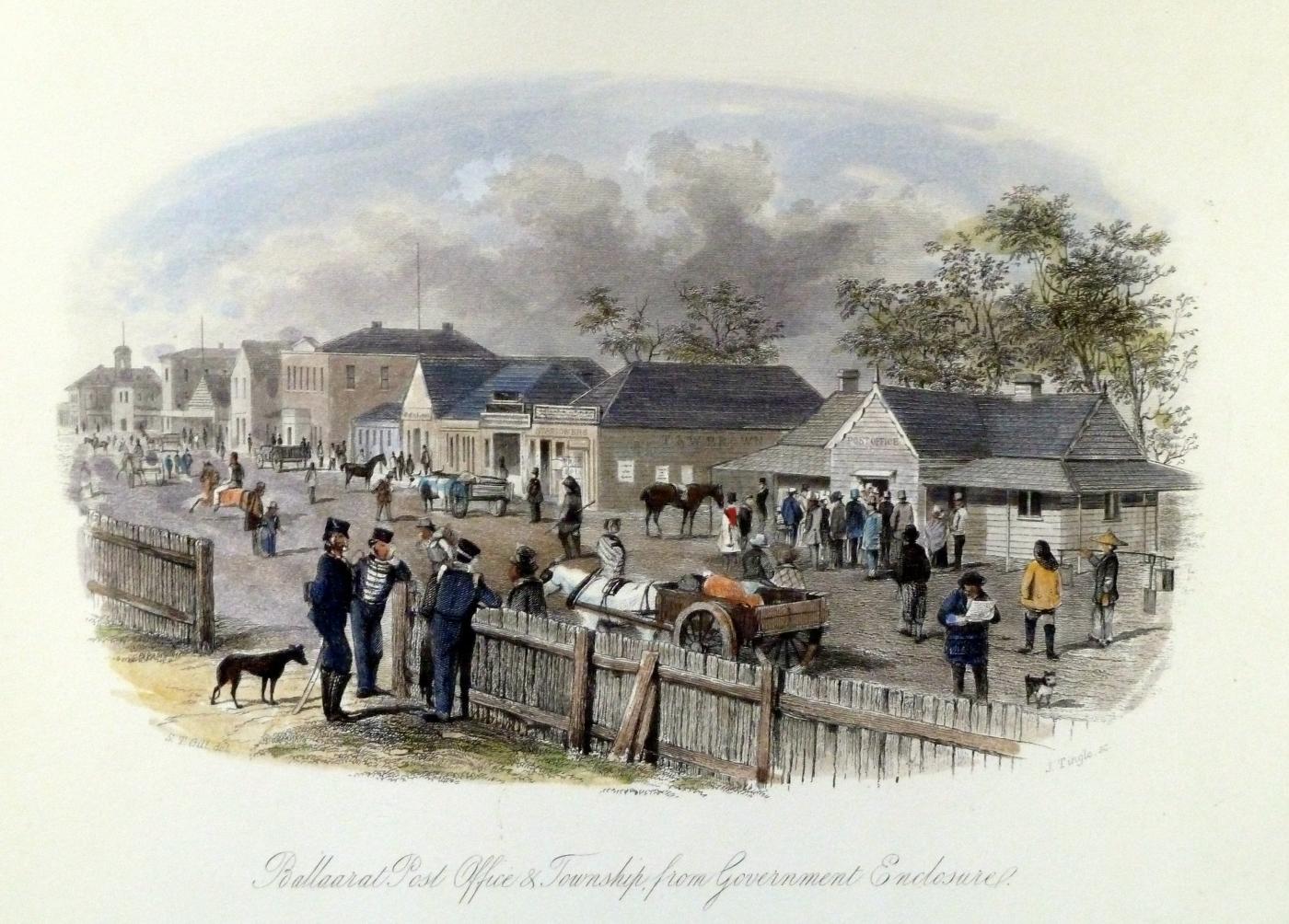
An artists impression by S. T. Gill of the Ballarat Post Office circa 1857, as visited by Hugh Taylor Cochrane,
Courtesy www.antiqueprints.com.au.
It seems Hugh Taylor and Catherine Cochrane deliberately chose to make and develop their lives in the late 1850s around Ballarat region, in particular at Linton. Their first son, Robert James Cochrane was born in a tent on the goldfields in 1857, and in adulthood became a local school teacher and head master at the Linton Primary School.

Headstone of Annie Cochrane, Robert Hugh Cochrane, George Oswald Cochrane, Robert James Cochrane, and Robenia Wilhemenia Cochrane, buried at Linton Cemetery in Victoria.
Kindly Note - Robert Hugh Cochrane shown on this headstone was the son of Robert James Cochrane and his wife Ann Richardson who died as an infant. Robenia Wilhemenia Aitken, who was the second wife of Robert James Cochrane.

Death notice of Robert Hugh Cochrane, infant son of Robert James Cochrane and Ann Richardson.
Their second child Mary Ann (Annie) was registered as being born in Ballarat in 1858, and was also registered much later as a part time teacher at Linton Primary School in 1875.

Official Education Department teachers list of 1875 noting Robert James Cochrane and his sister Annie Cochrane as Part Time teachers at Linton Primary School.
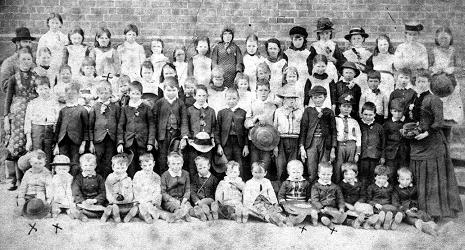
Staff and students at Linton Primary School in 1888 - Courtesy Linton and District Historical Society.
By 1860 it is obvious from Gold Mining Shareholder records of The Sons of Freedom Gold Mining company at Linton, Hugh Taylor Cochrane, joined forces with numerous neighbours and made a deliberate decision to change his previous vocation as a farmer, to that of a Gold Miner / digger, according to formal Victorian records. Even though Hugh's basic known financial investment of a single share in the local Sons of Freedom Gold Mine at Linton, if this was technically a "working share" and not a "sleeping share" it would mean Hugh would have been employed as an on-site worker, been paid a wage plus an appropriate weekly or monthly dividend, depending on the number ounces of gold found and declared by the Company Manager.
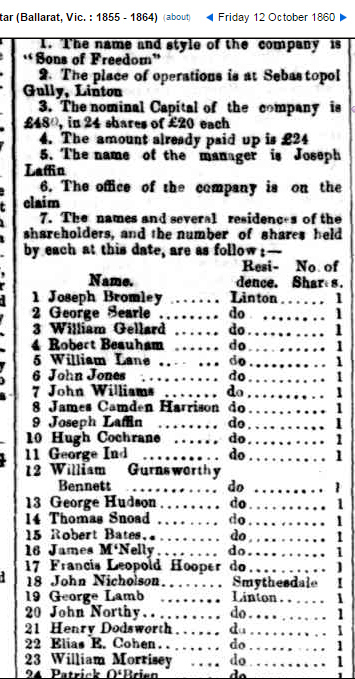
Shareholder record of Hugh Taylor Cochrane and his investment in the Sons of Freedom Gold mining company of 1860 at his home town of Linton.
The following newspaper cuttings relating to the Sons of Freedom Gold Mine, tend to indicate this Gold Mine had a reasonably consistent rate of success and dividend payments, however notations in the Victorian Government Gazette did not mention this mine, as rewarding its investors of any outstanding finds or successes, during this time frame.


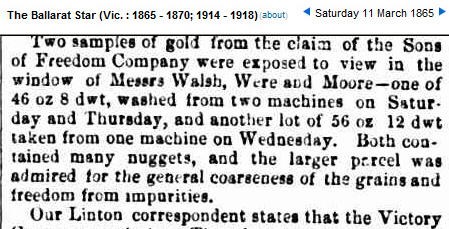
Later records of the Sons of Freedom gold mining Company at Linton, in 1862 and 1865 above and later in 1869 below.

As shown in this newspaper cutting above of 1869, The Sons of freedom Gold Mine was still paying solid dividends.
The remainder of their children Oswald, Laura #1 and Laura #2 and Emma, were born at Linton, about thirty miles southwest of Ballarat.
More information about this Cochrane family, please refer to ancestry.com re
Robert Cochrane born 1778 in Eglington and his wife Jane Tully
or download Cochrane Family History PDF document, with thanks to Jenny Hawkins.

GEORGE SAMUEL COCHRANE, born 1829 BAMBURGH U.K.
George Samuel Cochrane, was baptised on 17 May 1829 at Bamburgh Northumberland, being the seventh surviving child and sixth surviving son of Robert Cochrane and Jane Tully (they only had one daughter Alice Tully Cochrane). George was schooled locally as a youngster at Newham, and by the age of 21, the 1851 U.K. Census lists him as a joiners apprentice whilst residing on the family farm. Four years later, the Australian emigration register has him aged 26 in August of 1855 on board the Donald Mackay, and his occupation as a tailor, however there are some known recorded discrepancies in the Cochrane brothers vocations of this decade.

Portrait (inset) of Mrs George Samuel Cochrane - Anna Marie Kennedy.
With special thanks to Cochrane family historian, and descendant of George and Anna Cochrane, Jenny Hawkins from New South Wales, it is a rare honour and privilage to be able to display the above inset of this very old portrait of George Samuel Cochrane's wife Anna Marie Kennedy from circa 1897. The following picture is the only known photo of any of the Cochrane family whom emigrated to Australia in the 1850s, and any of their children!
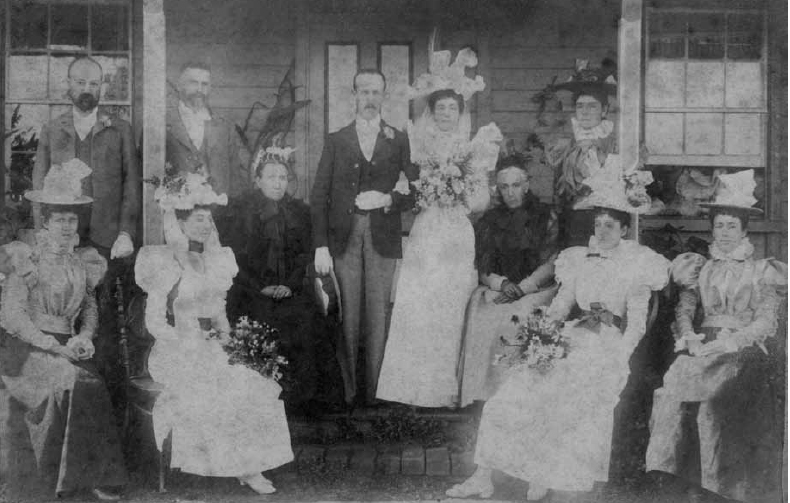
The above photo, as described by, and to directly quote Jenny Hawkins -
"This photograph was possibly taken at the wedding of Edith Hasemer to Gerald Cochrane. Anna Maria Cochrane is seated on the bride’s
left and George Cochrane is standing on the verandah on the left of the post.(courtesy Stuart Railton) The wedding can be approximately
dated to 1897 and was not taken at Arden Lea, where Lucy Cochrane was married. Arden Lea was built of stone and there were glass
panels on either side of the front door."
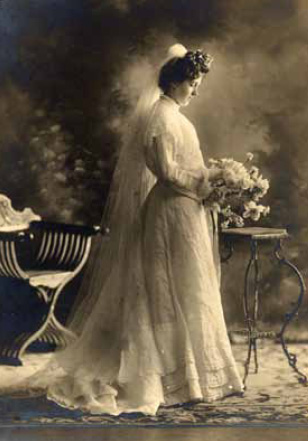
An exquisite photo of Esther Maude Cochrane on her wedding day on 21 October 1902.
Courtesy Jenny Hawkins of New South Wales.
George Samuel Cochrane from Oxley Plains near Wangaratta, married Anna Maria Kennedy in 1861 in Beechworth in Victoria. Anna Maria was born in Dublin, Ireland, to George Edward Kennedy and Catherine McKercher.
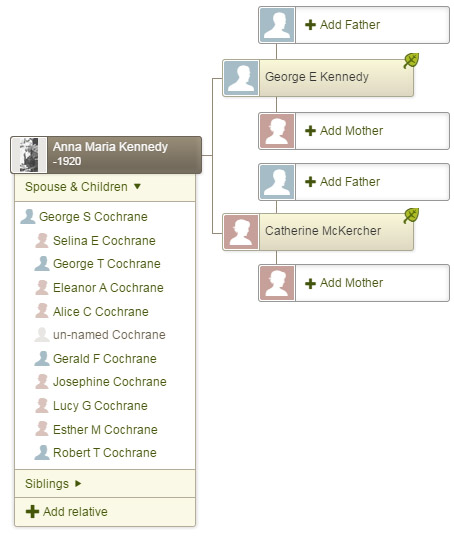
Timeline of Anna Maria Cochrane nee Kennedy, George Samuel Cochrane, and their children.
At the time of their marriage George Samuel Cochrane was working as a farmer at Oxley Plains, a small hamlet on the southern edge of Wangarrata township, and is now known as Oxley Flats. Penny Weight Flat was where Anna Maria was living in 1861, could be described as close to the centre of Beechworth township itself, near enough to have a dip in the nearby Spring Creek on a hot Summers day.
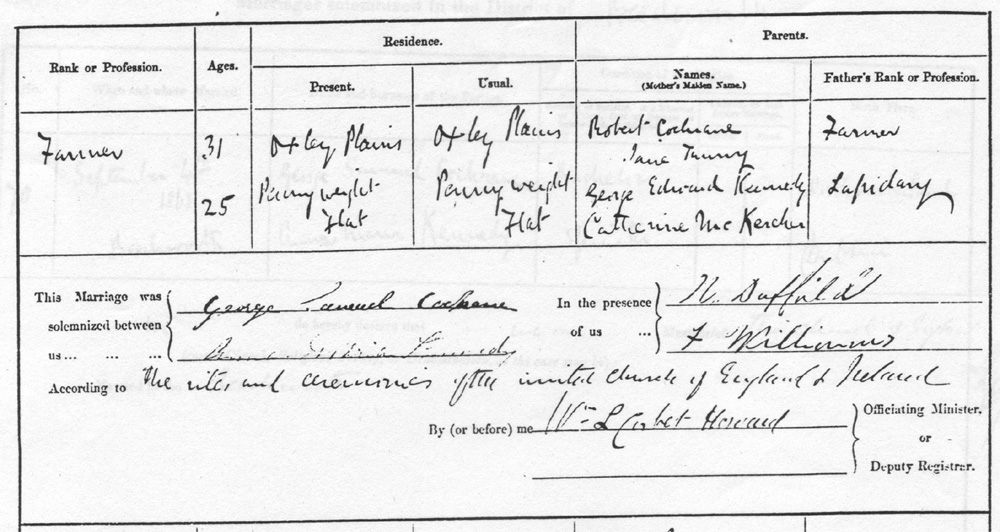
Left hand part of George Samuel Cochrane and Anna Maria Kennedy's Marriage Certificate of 1861.
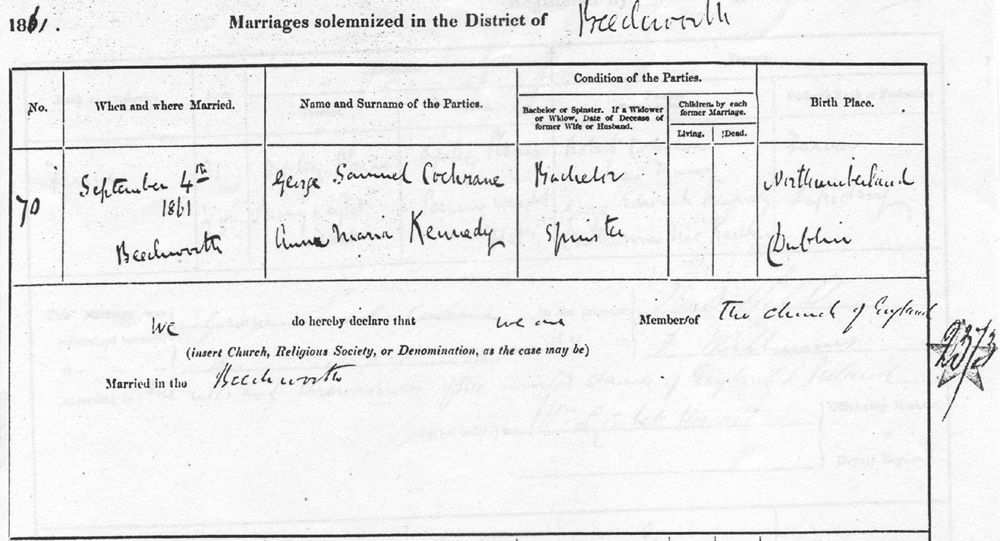
Right hand part of George Samuel Cochrane and Anna Maria Kennedy's Marriage Certificate of 1861.

Parish Map of 1850 showing Oxley Plains near the King River, on the southern edge of the township of Wangaratta.
Following the researchers practice of tracing Birth records of children, one may surmise out of the 5 Cochrane brothers who came at first to the Victorian Gold fields, George Samuel and Anna and their family moved the furthest away from say Linton near Ballarat, where eldest brother Hugh Taylor appeared to be content to settle and remained there all his life.
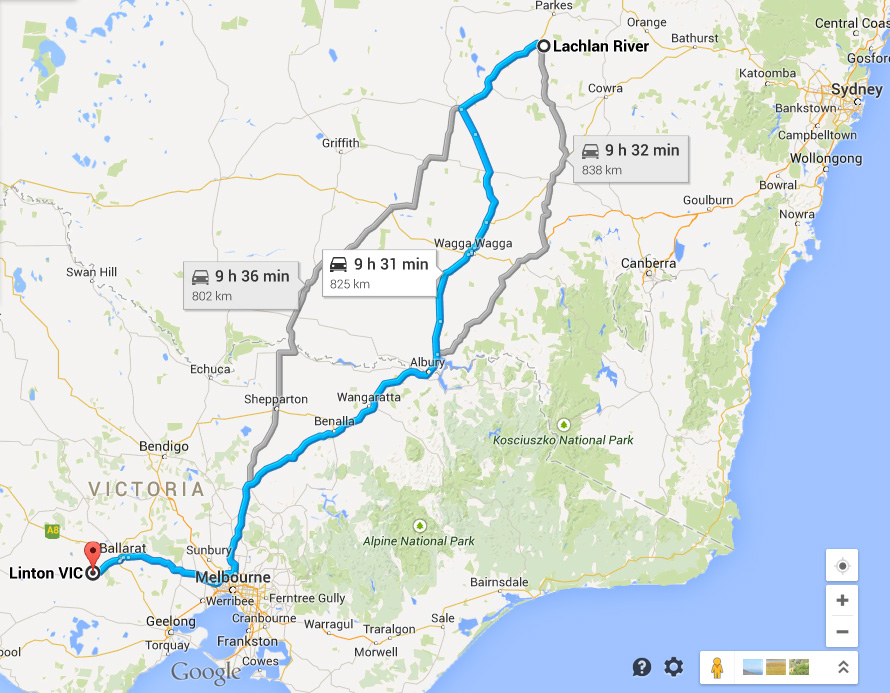
Google map showing Linton Ballarat Gold fields, and the Lachlan River district of NSW, well inland from Sydney, NSW.
It appears these Cochranes travelled a few times between the Beechworth district in Victoria (close to Wangaratta on above map) and around Forbes, Wellington, and Orange in New South Wales, where George Samuel and Anna Cochrane eventually settled in the mid 1860's, with many of their children ending up later in the suburbs of Sydney.
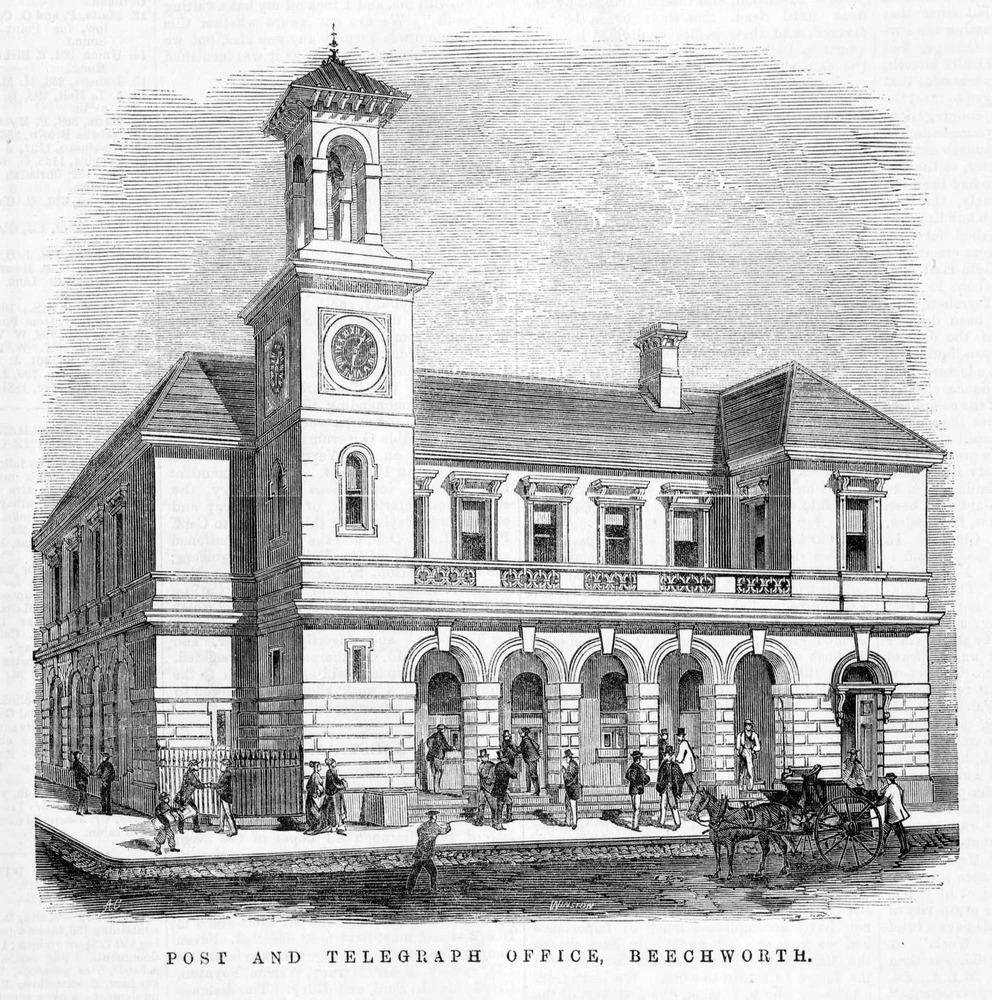
Engraving of Beechworth Post Office in 1869 by Winston - Courtesy State Library of Victoria.
The birth of George Samuel and Anna Maria's first two children near Beechworth in Northern Victoria, implies they probably spent most of their first decade in Australia until about 1865, living reasonably close to brothers Thomas and Percival Cochrane. The distance from Oxley Plains near Wangaratta, where George samuel was living when he married, to Oxley near Bright, where Thomas and Percival had their two blocks of land, is about 75 kilometres.
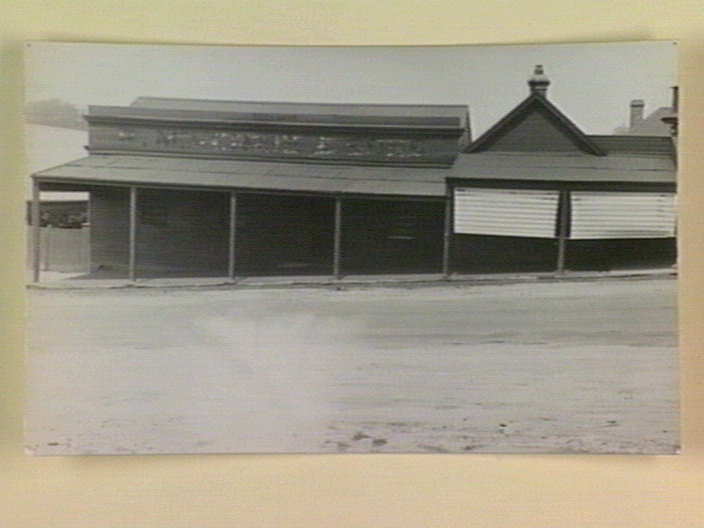
McKenzies old store, established in 1855, situated on very steep Newtown hill, about three-quarters of a mile from Beechworth Post Office. Courtesy State Library of Victoria.
Sadly their first born at Newtown near Beechworth, a daughter Seline Ellen died at the age of 6 months in 1863 at Forbes in New South Wales, her death there indicating an initial family interest in this region around the Lachlan River, close to Orange and Wellington. This particular primarily pastoral region was still undergoing early settlement, yet statistically already had 732 residents.
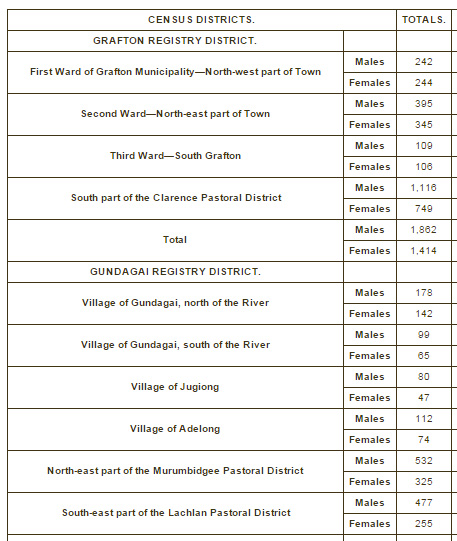
Census Lachlan Pastoral district of NSW in 1861 - Courtesy HCDDA
As her father George Samuel was known to be an engineer around this time, and Seline Ellen actually died at the Red Streak Lead, a gold mining site, its highly likely George was investigating mining work possibilities or may have been employed at this gold mine near the Lachlan River in 1863.
For a more in depth overview of the Gold Mining activities around the Lachlan River region near Forbes, where George Samuel and his family spent many years, please refer to
www.goldtrails.com.au.
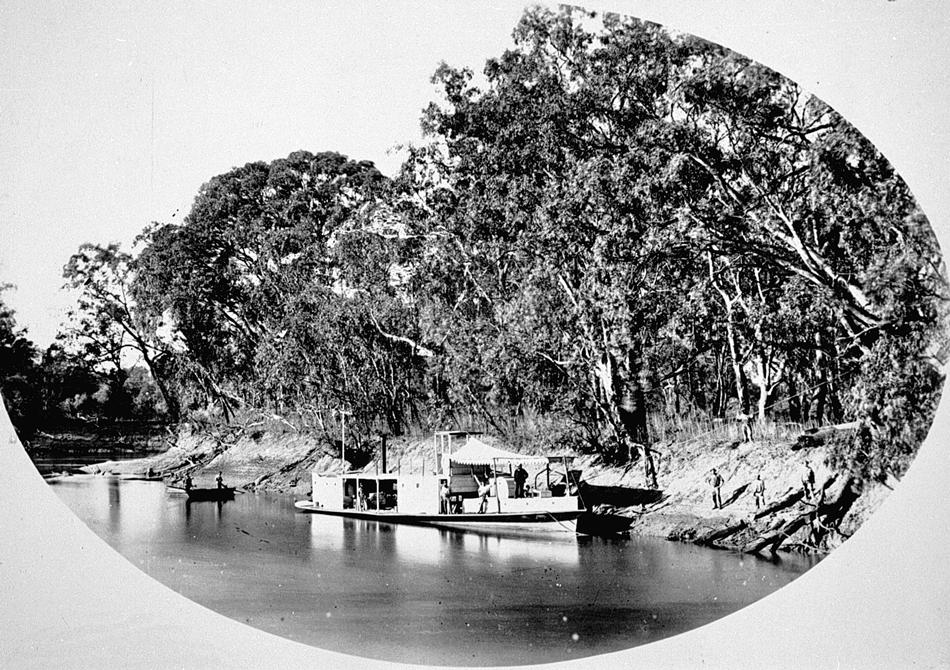
Boating scene on the banks of the Lachlan river in 1878. Courtesy Museum Victoria.
Next in line was their first son George Thompson Cochrane, who was born back in Beechworth in Victoria in 1865. Their third child Eleanor Annie Cochrane was born at Caleula near Orange in New South Wales in 1866, which is about 250 kilometres inland from the coast, and a little further north than Sydney.
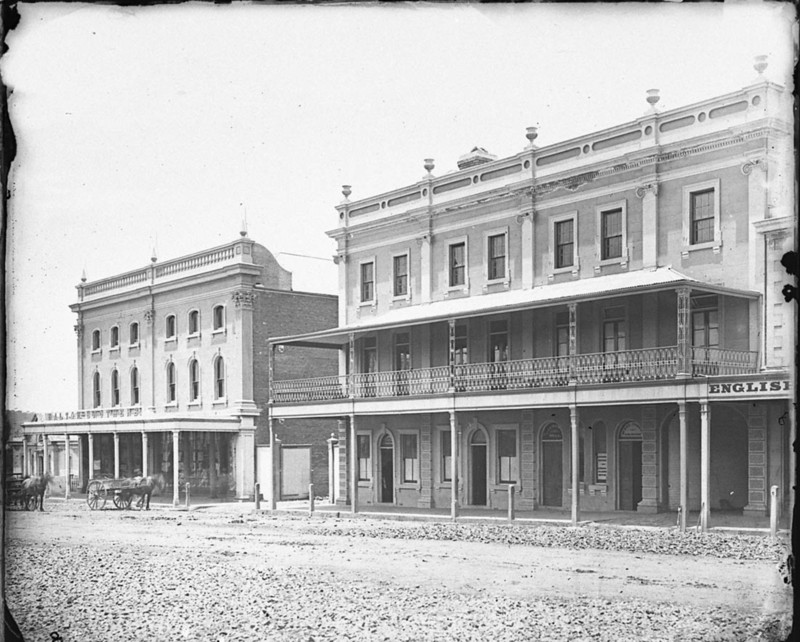
A great old photo of the Dalton Bros stores on Summer Street in Orange N.S.W. in the 1870s. Courtesy wikipedia.
The visual impression of the above photo, would have been pretty much how George and Anna Cochrane would have seen the main street of Orange, when they came to town to do their shopping from their home at Caleula, where it is believed they lived in 1866, (as per the following birth record of Eleanor Annie Cochrane).
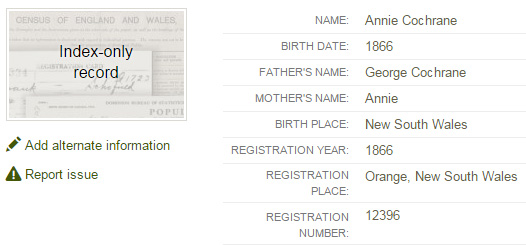
George Samuel and Anna Cochrane eventually had another 7 children in the general region in and around Orange, Wellington, Kerrs Creek, Caleula, and Mullion Creek, making 10 children in total.
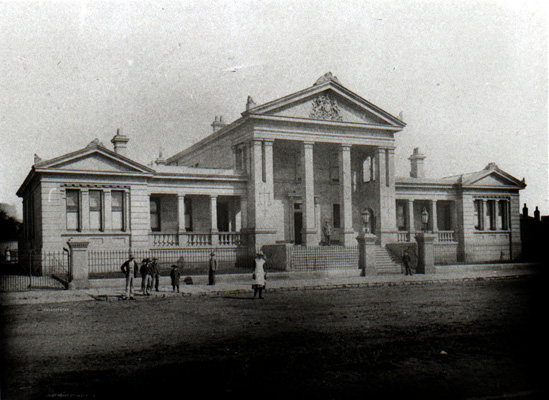
The Orange court house building in 1887 - Courtesy www.designbase.com.
It would appear this Cochrane family had quite some dealings and attractions in the capital city of New South Wales, in Sydney, as derived from the records and movements of their children. For example, their third surviving daughter, Josephine Harriet Cochrane was born in 1873 at Wellington, married a city boy from Sydney actually in Sydney, Herbert George Beaumont, and they both passed away in Sydney. Another few children were also married in and around Sydney, five out of these 10 Cochrane children passed away in the suburbs of Sydney.
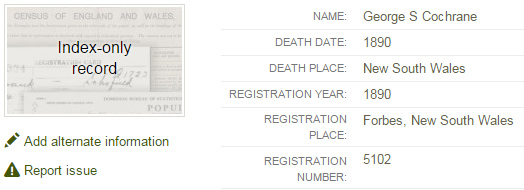
Death Record of George Samuel Cochrane at Forbes NSW in 1890. Courtesy ancestry.com
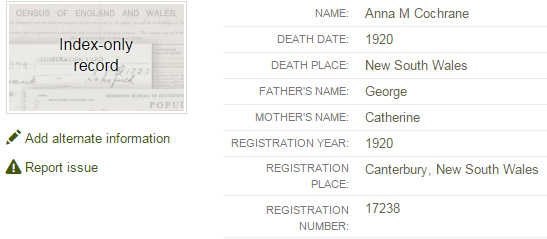
Death Record of Anna Maria Cochrane nee Kennedy at Canterbury, Sydney, NSW in 1920. Courtesy ancestry.com
For a detailed overview of George Samuel and Anna Cochrane and their children, please go to ancestry.com
or download Cochrane Family History PDF document, with thanks to Jenny Hawkins.

PERCIVAL COCHRANE, born 1835 at Lucker U.K.
Youngest of the Cochrane boys, Percival Cochrane was baptised on 30 August 1835 at Lucker, just a bit over 3 miles from Bamburgh heading inland from the North Sea coast of England. From a meagre amount of information gathered about Percival, it appears he was borne of a different nature and makeup in some noticeable ways, in comparison to his elder siblings. At the quite young age of 16 on the Census he was noted as being employed as a tailor journeyman, whereas his older brothers were either doing heavy manual work on the family farm or in local coal mines. Also, without being able to sight all the actual marriage certificates of so long ago, his brothers appeared to legally marry, yet no marriage record has been located with his eventual partner Anastasia Murphy in Victoria, for whatever unknown reasons.

According to the formal Letter List at the Beechworth Post office, Percival Cochrane and his brother Thomas Cochrane were due to collect their mail in 1857.
About aged 20 Percival boarded the Donald Mackay at the Liverpool Port, along with 3 of his older brothers and two sisters-in-law, and sailed into Hobsons Bay in Melbourne in Aug of 1855. On the emigration record upon his arrival in Victoria, Percival Cochrane is actually noted as a Mason and not a Tailor journeyman as in the earlier UK Census of 1851. Apart from Percival's joint land purchases with eldest brother Thomas at Oxley in 1858, there aren't many records to relating to young Percival himself, apart from the birth of his children with Anastasia Catherine Murphy, and his sad death whilst mining for gold on the Mitta Mitta River in 1890.
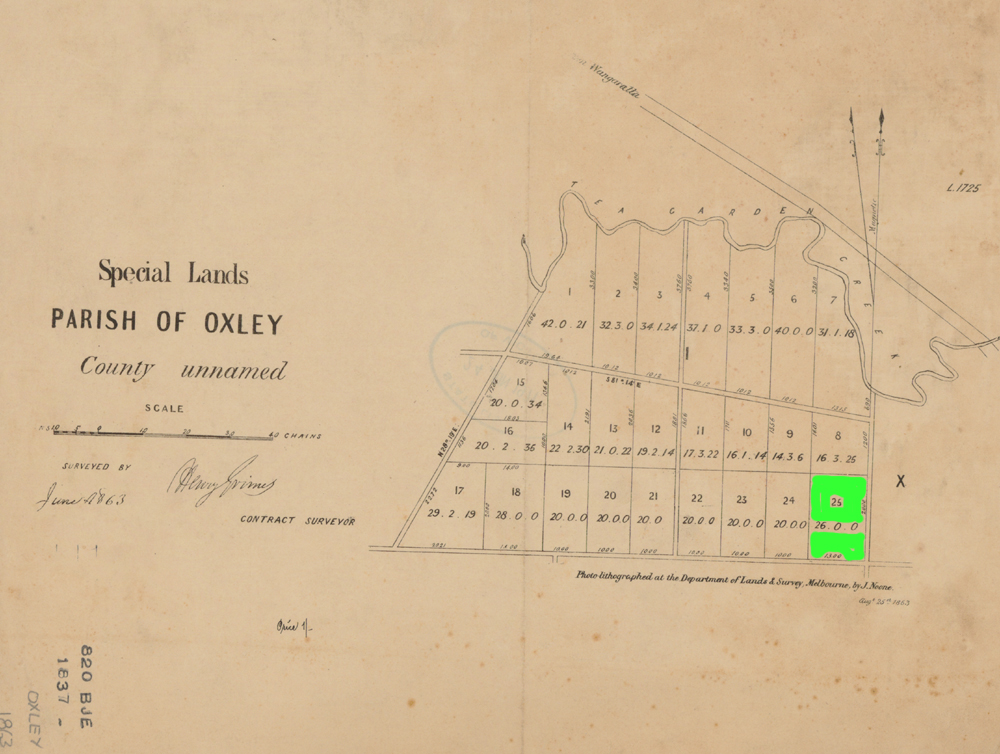
Oxley Map near Bright, showing Title 25, one of Thomas and Percival's blocks of land they purchased together in 1858.
This is an 1837 Parish Map of Oxley, (where Percival's nephew Robert was born in 1860 to Thomas and Sarah), located between Bright and Harrietville - NOT to be confused with Oxley Plains on the southern edge of Wangaratta, near what is now known as Oxley Flats Road. Title 25 is on the bottom right side of this map - The first block brought by Thomas and Percival as mentioned above. Thomas and Percival's second block, Title 56a has not yet been allocated on this map. Map Courtesy State Library of Victoria.
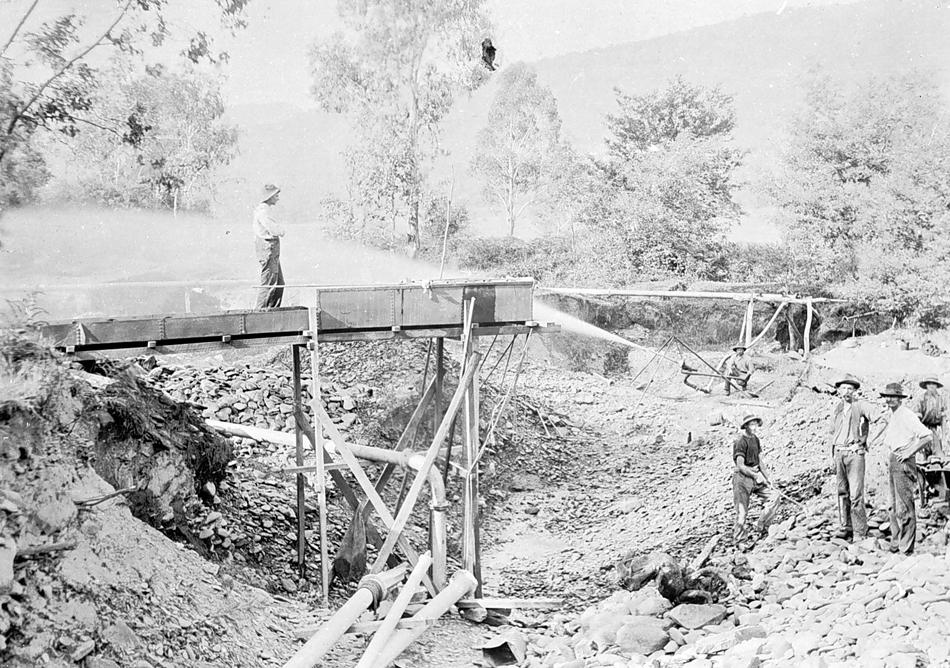
Bright sluicing operation - 1890 Courtesy Museum Victoria.
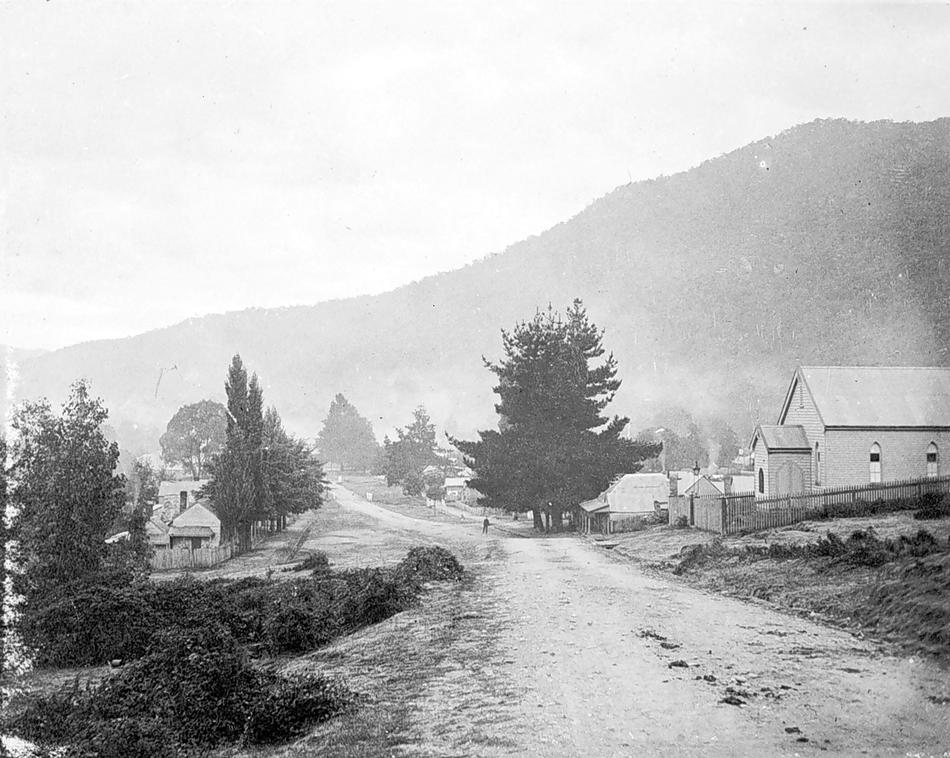
Harrietville - 1913. Courtesy Museum Victoria.
However tracing his partner Anastasia Muphy's movements after Percival's death has resulted in some success thanks to Victorian Census post 1900. Courtesy of the State Library of Victoria, it is has been possible to put together an excellent visual impression displayed below of the landscape, rugged terrain, and the quite treacherous mining site of the Pioneer Sluicing Company where Percival Cochrane worked at Mitta Mitta in the late 1880s.
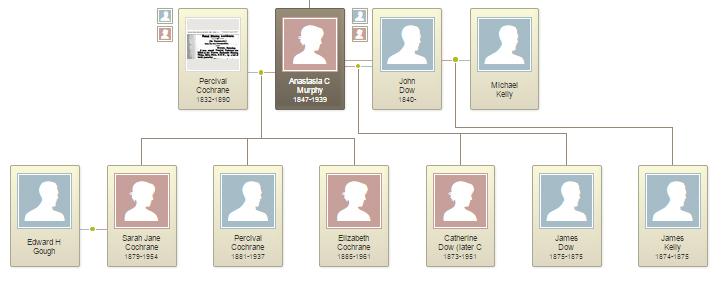
Brief Timeline of Anastasia Murphy, outlining her marriage to Michael Kelly, relationships with John Dow, and Percival Cochrane, and six known children, James Kelly, Catherine and James Dow, and Sarah Jane, Percival (junior) and Elizabeth Cochrane. Catherine mentioned here took on the Cochrane surname in her adult life in all located census records, presumably as she was raised by Percival and Anastasia
To obtain a clearer impression of how remote the region around Omeo was back in this period, and how popular it was with local miners like Percival, please review the following article entitled -
A summary of Omeo.
By a correspondent, Gippsland Times newspaper 18 Aug 1868.
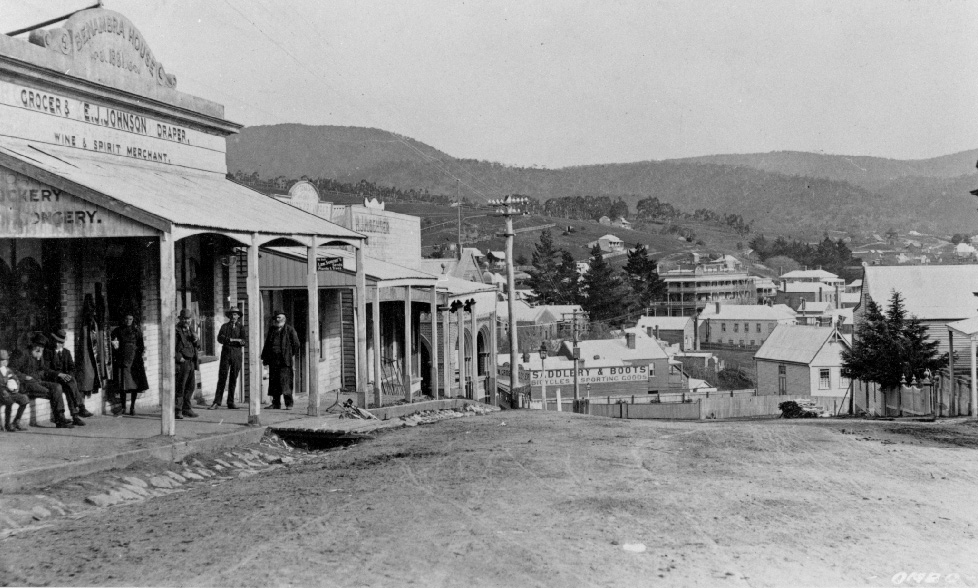
Main Street Omeo in 1910 - Courtesy Omeo Historical Society.
Any person looking at a map of Victoria will observe a large area lying between the Mitta Mitta river and the Indi
or Upper Murray marked with a few streams evidently put in at random; but the centre from which a considerable
portion of these waters must proceed, left blank. In fact, it has never been surveyed. In some of the latest maps, however, two short ranges are introduced, one designated the Benambra mountains, the other Mount Gibbo, to the south of the watershed of Gibbo Creek. Now this
Gibbo range forms the southern edge of a large basin of which Lake Omeo is the centre, and Gibbo creek (or river) drains
the whole of the country, and forms an important feeder to the Mitta Mitta which it enters a little above the mouth of Wombat Creek, but on the opposite side of the Mitta.
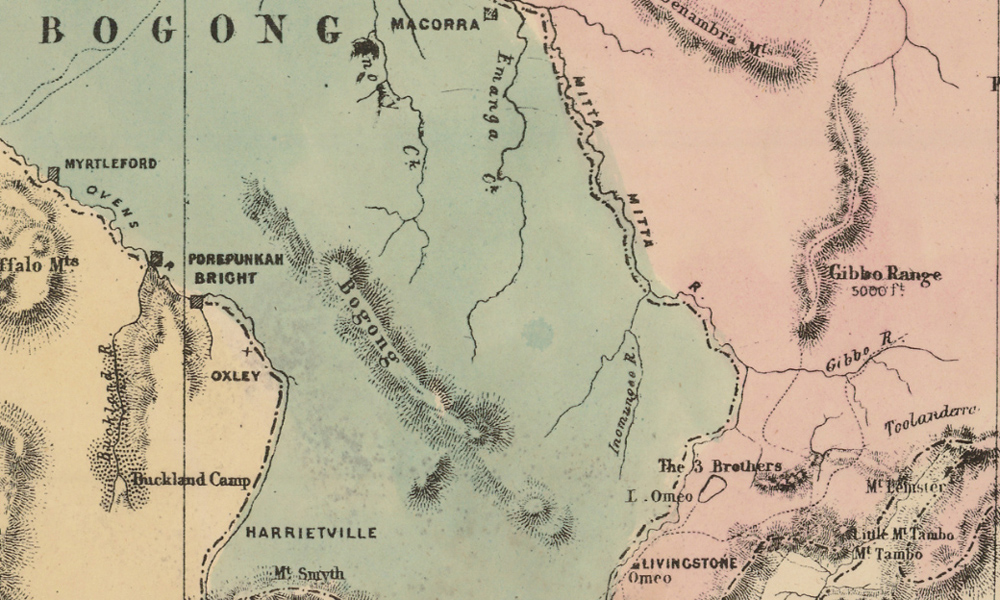
Inset of 1860s Parish Map.
Gibbo Creek is now being rushed for the third time. On the two former occasions it was the lower part of the creek that was occupied, and
a few Chinese are working there still, but this time it is the top of the left branch that has been taken up at the junction of two small creeks christened saltpetre and sassafras, one of which heads not far from Wheeler's Creek, on that part of the main range known as "Thirty Mile Gib," but on the opposite side of the range. There are about 100 men on the ground, and more are coming in daily, but only a dozen claims are so taken
up. In fact, though there are some rich points, the ground is very patchy and so limited that the prospectors themselves only took up an ordinary creek claim.
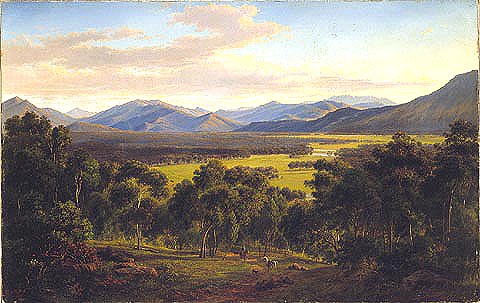
Painting titled Spring in the valley of the Mitta Mitta, by artist Eugene Von Guerard in 1866.
There is, however, any amount of country unexplored from Pender's station at Mount Leinster to Mount Koscioszko, but unfortunately this is not the time of year to prospect it, and anybody that tries will probably have to go through considerable hardships; for in these elevated regions
snow storms, such as may be seen at Kiardina, are not uncommon. I have reason to believe that Mr. Selwyn, and the Rev. Mr. Clark thought highly of it
as an auriferous country, and I trust next summer will see some of the hidden riches which both these gentlemen confidently predict to exist there will be brought to light. As to surveying and mapping the country, I fear that is not to be hoped for till the boundary line is run between us and New South Wales."
End of article.
Let's take a moment to ponder over why there may not be many records of Percival back in those time. This region of North East Victoria along the Mitta Mitta River runs through the huge mountains of Great Dividing Range, is fed by its main tributary the Big River, and is still regarded these days as very picturesque yet quite remote. The tiny hamlet of Mitta Mitta was originally named "Junction Snowy Creek" and the hamlet was initially built upon the original Station called Mitta, selected by pastoralists James and William Wise in the mid 1830s.
As a matter of interest, there is an unconfirmed report of a son of Anastatsia Murphy / Cochrane with her second partner John (Jacky) Dow, named James, is said to have died at Big River in July of 1875, under the age of 1 year.
The following is a basic outline of Percival's employer, the Union and Pioneer Mining companies, where he passed away in 1890. It is fortunate there are a number of great old gold mining images available, and the Pioneer Gold Mine was such an extensive operation, it had its own Parish map, as shown here -
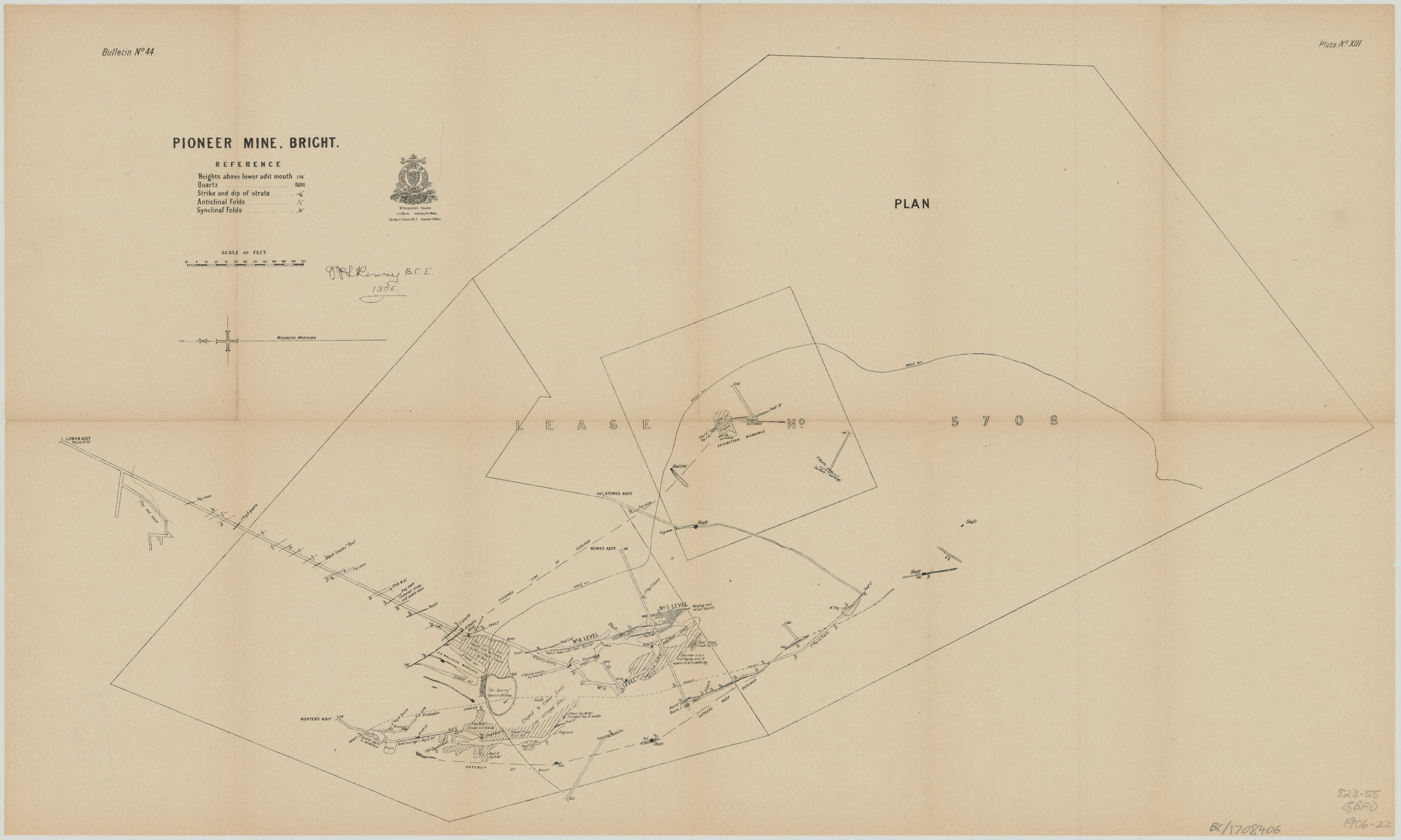
Parish Map of the Pioneer Gold Mine near Bright of 1906. It was still quite a major Gold Mining operation after Percival Cochrane died there in 1890. Some additional info about the Pioneer Mine and ownership can be viewed here at mininglink.com.au.
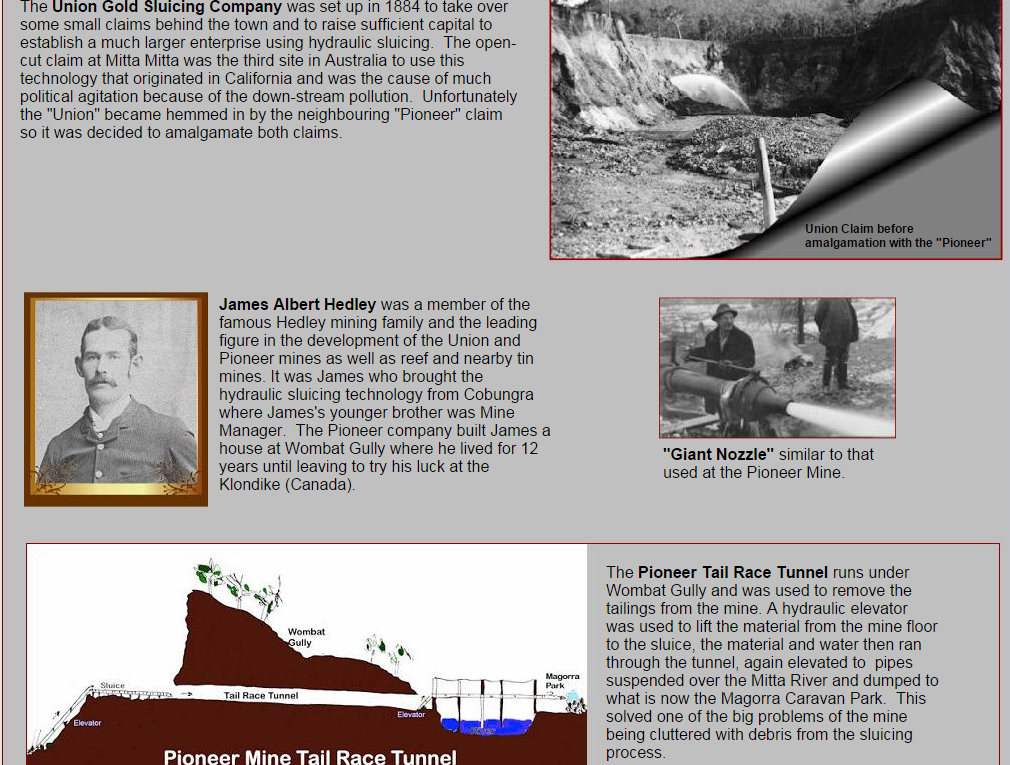
Percy's work site - The Pioneer Hydraulic Sluicing Company at Mitta Mitta South - Courtesy mitta.com.au.
A close examination of the following 5 photos of the Pioneer Hydraulic Sluicing Company, should provide a great visual interpretation of the terrain and extreme circumstances Percival Cochrane was working under, in the 1880s.
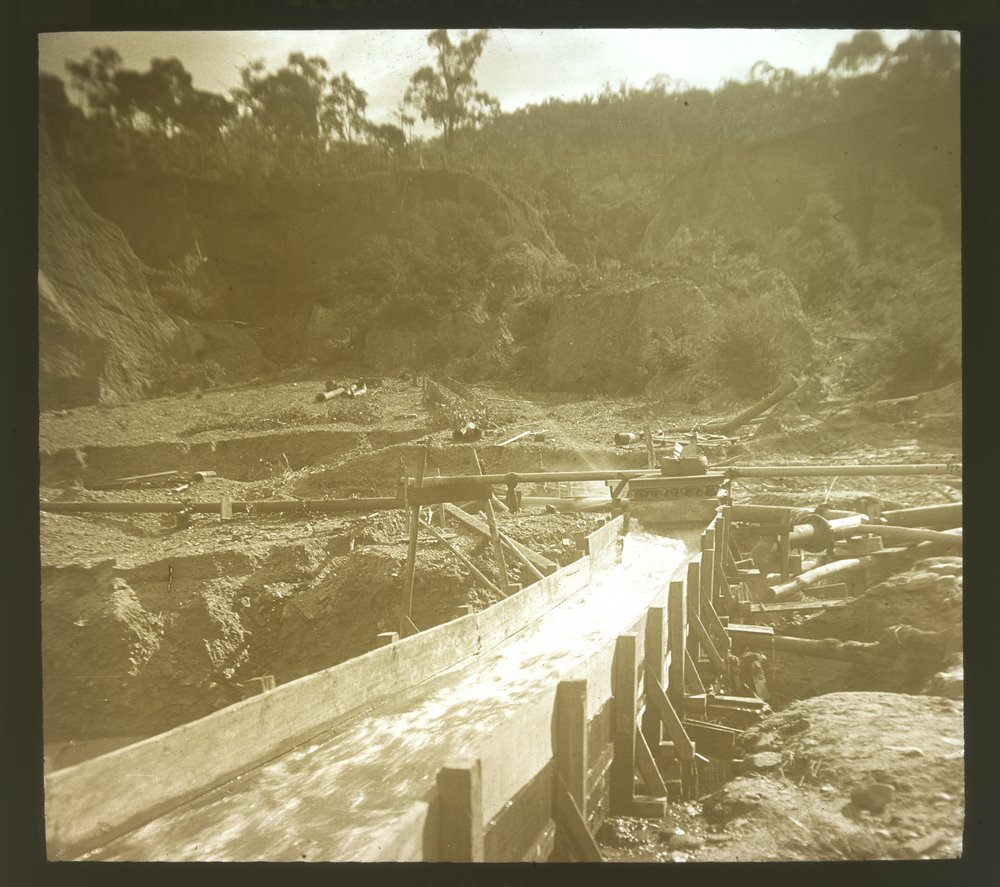
A classic example of the Californian Pumping / Sluicing system adopted in this particular Pioneer Gold Mine at Mitta Mitta.
This type of sluicing system has spaced cross members on the base of the channel, which both strengthened the structure and also captured the gold, because the heaviness of the gold naturally made it settle to the bottom, even if there was a large amount of water flow and pressure.
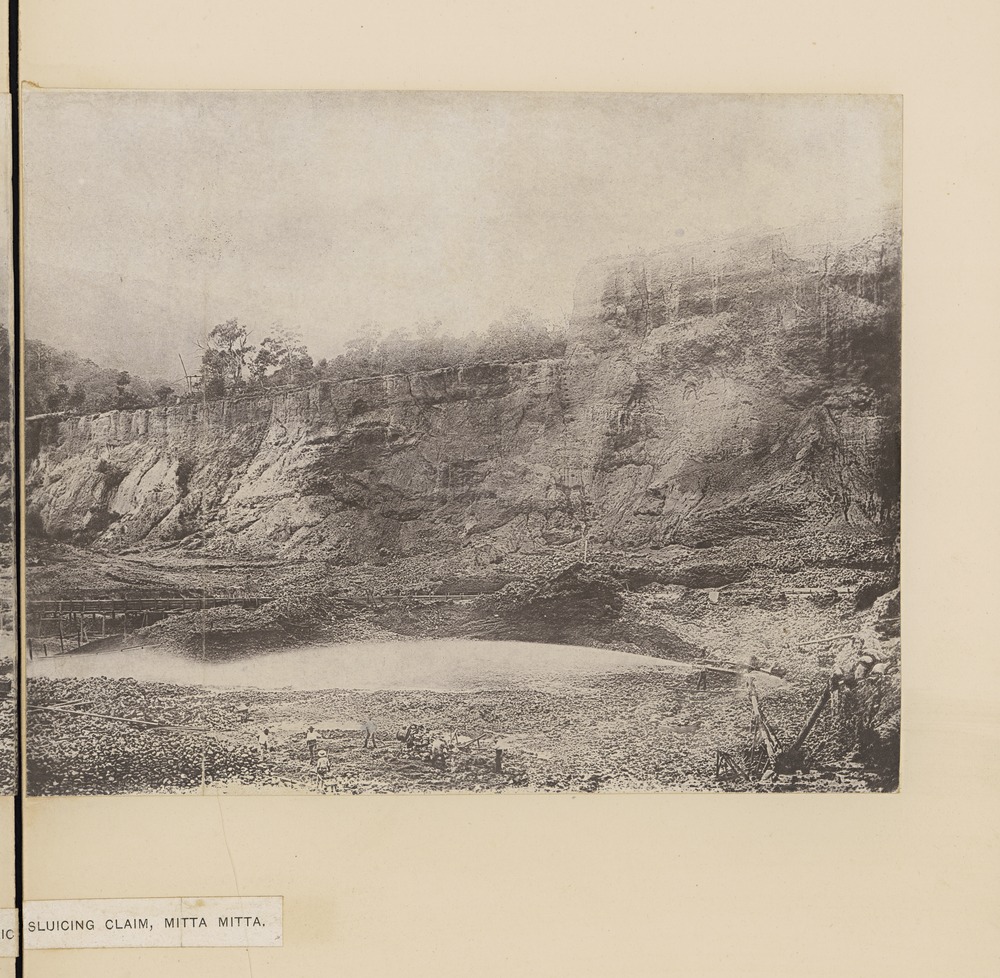
Photo showing a few miners at the base of the gully below very rugged and steep terrain on the Pioneer Gold Mining claim. From what appears to be a giant nozzle jet system, working such a steep cliff face would have washed a bulk amount of gold dirt wash to the bottom of the gully, in readiness for sluicing box separation.
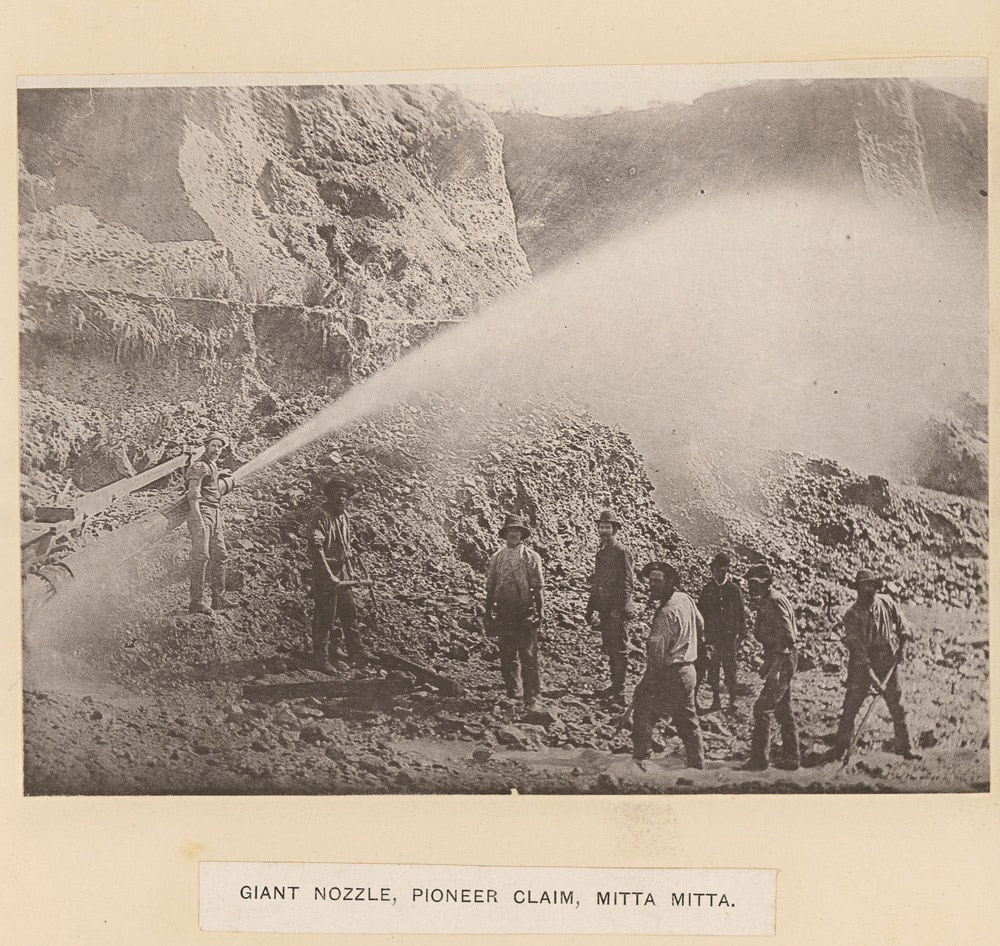
The Pioneer Sluicing Company a Mitta Mitta near Beechworth, where our Percival Cochrane was employed in the late 1880s. Its likely one of the miners pictured here may have actually been Percival Cochrane!
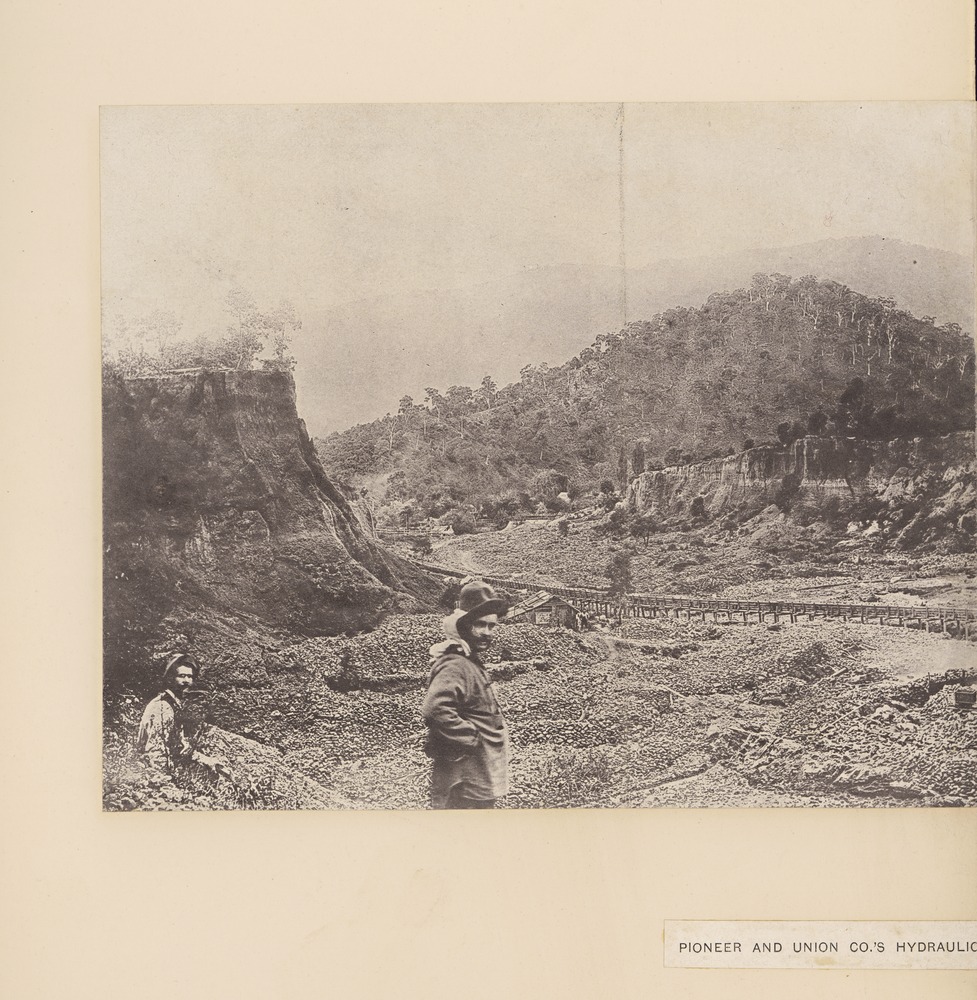
That's some sort of pretty long Sluicing operation in this valley. Check out the steepness of the gulleys, and the miners hut in the centre of this photos, would have had only the very basic survival essentials, like a table, bunks, and a woodstove, well before running water in a standard miners hut.

This photo above in particular, portrays a very clear impression of the steepness of the hillside where the Pioneer Sluicing Company were working in the late 1880s, and to a degree, visually outlines the circumstances when and where Percival Cochrane passed away as per the newspaper cutting below.
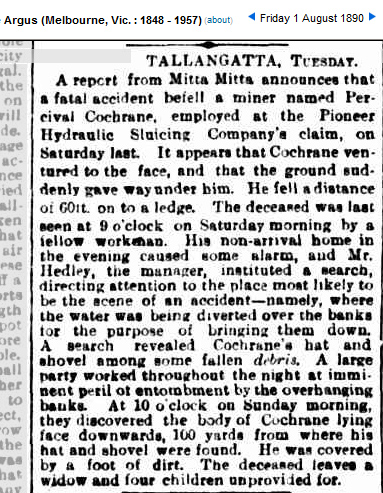
Death notification of Percival Cochrane killed by a land slide at the Pioneer Sluicing Company at Mitta Mitta in Aug 1890.
In order to clarify Percival's family responsibilities when he died in 1890, this article mentions that he left a wife
and four children, being Catherine, the daughter of John Dow and Anastasia born in 1873, and Percival and Anastasia's own children, Sarah Jane Cochrane born in Omeo in 1879, Percival Cochrane (junior) born 1881, and Elizabeth Cochrane born in Mitta Mitta on 24 Apr 1885. Diligent records searching by a few family researchers have not been able to confirm a legal marriage between Percival and Anastasia.
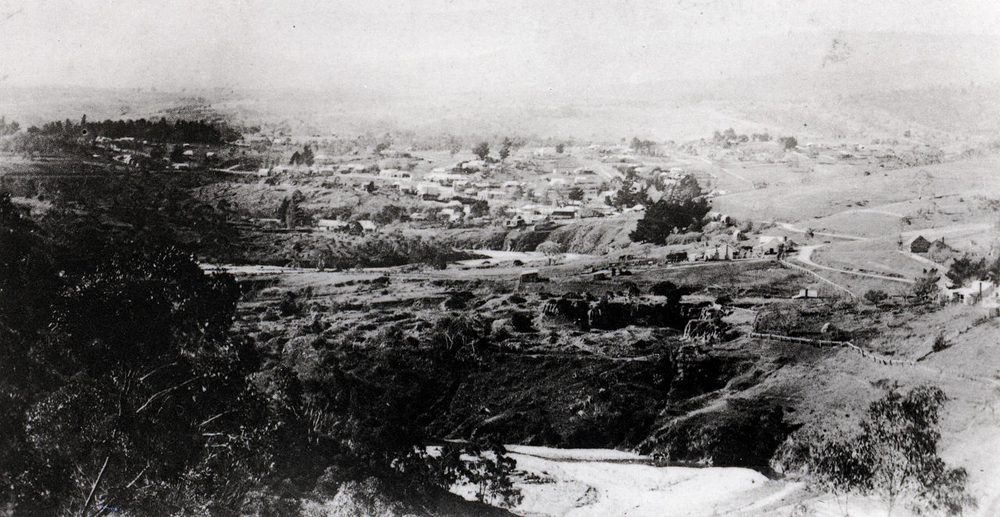
View of Omeo from the Oriental diggings, photo by G Hobson C1890s - Courtesy Omeo Historical Society.
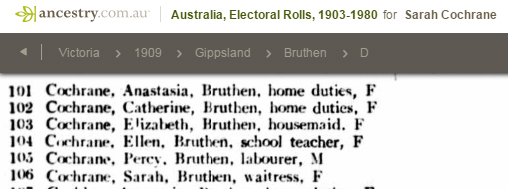
1909 Census record of widowed Anastasia Murphy, residing in Bruthen with her surviving family close by.
After quite some research into Ellen Cochrane listed here, we are not sure exactly who this school teacher Ellen Cochrane is, although from Anastasia's life long record of living with family, notably her children, it is possible this Ellen was a niece, a cousin, or possibly a daughter of her first husband Michael Kelly? We do know for sure Catherine was John Dow's daughter, and Elizabeth, Percy (junior) and Sarah Jane were Percival Cochrane's children. The following Census records of Anastasia's just before she passed away in 1937, confirm a close family bond and pattern of living with her family nearby.
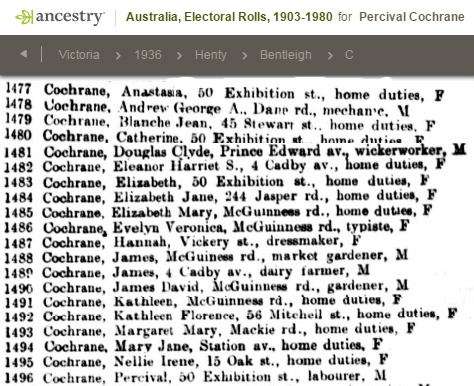
Last census of Percival Cochrane (junior) with his mother Anastasia Murphy nee Cochrane, and his sisters Catherine and Elizabeth, at 50 Exhibition St Bentleigh / Mc Kinnon in Melbourne, under 12 months before he passed away in Orbost in East Gippsland in 1837.
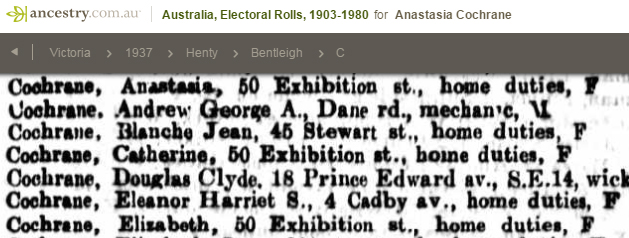
Last Census of Anastasia Cochrane nee Murphy, with daughters Catherine and Elizabeth living with her at 50 Exhibition St Bentleigh in Melbourne.
Anastasia is officially recorded as dying in the Melbourne suburb of Campbellfield in 1939, which is quite a ways on the other side of Melbourne from her home suburb of Bentleigh / Mc Kinnon - in reality it was possibly a record error, and her death may have actually occurred in the nearby suburb of Camberwell, not Campbellfield. She was registered then as Anastasia Cochrane and her death certificate listed a son Percival (junior), who had previously died in Orbost in 1937. Sarah Jane married Edward Gough in 1911, who was a publican, but the marriage appears not to have lasted very long, so Sarah subsequently worked as a waitress. Records indicate Elizabeth never married.

HENRY JAMES COCHRANE, BORN 1821 BAMBURGH U.K.
Henry James Cochrane was born in Bamburgh in 1821, and baptised there on 2 December 1821. There is not a great deal of confirmed information of the life and travels of Henry James, either in the United Kingdom or Australia, so from a family researcher's point of view, he was a bit of a "Mystery man". The next chronological record available for Henry James Cochrane is the 1841 U.K. Census, which notes him as 15 years of age, living with his family, in the official Registration District of Belford, in the Civil Parish of Bamburgh, Northumberland, U.K..
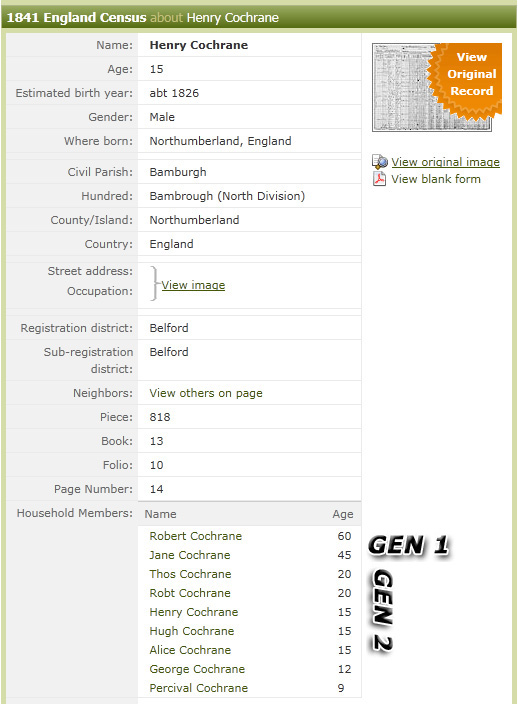
Our Cochrane family record of the U.K. Census of 1841.
As you can imagine, compiling a substantial amount of data and details directly based upon the U.K. Government Census records for all our family members who emigrated from England, has created a very positive impression, and much due respect, that these very early records were generally compiled with an extremely high degree of accuracy, and attention to detail. This particular Cochrane record is quite exceptional, as it seems to display a number of obvious errors, as far as the childrens ages are concerned.
This U.K. Census of 1841, appears very inaccurate regarding ages of the children. Thomas was actually baptised 18 months earlier than Robert, Henry James would have been about a year older than Hugh Taylor, who was in turn roughly 2 years older that sister Alice. Even so, it was the task of the Census officer of the day to record details as advised, so one may assume numeracy regarding dates and ages of the children may not have been a Cochrane family strongpoint. It has not been ascertained if first born son John had actually left home, or possibly may have even died at the time of this Census.

The 1851 Census shows Henry James Cochrane has since married, and has a 2 month old son John, born in Embleton.
The earliest record located to date relating to the whole Cochrane family goes back to the birth of Elizabeth Caroline Watson, Baptised on Jan 14 in 1821, daughter of John Watson and Mary Elliot from Shank hill farm in Belford, who ended up marrying Robert Cochrane and Jane Tully's fifth son, Henry James Cochrane. It was Henry James Cochrane and Elizabeth Caroline Watson's second son Robert Cochrane, who married our Elizabeth Richardson in 1881 in Victoria, hence this important link by marriage to our Richardson family.
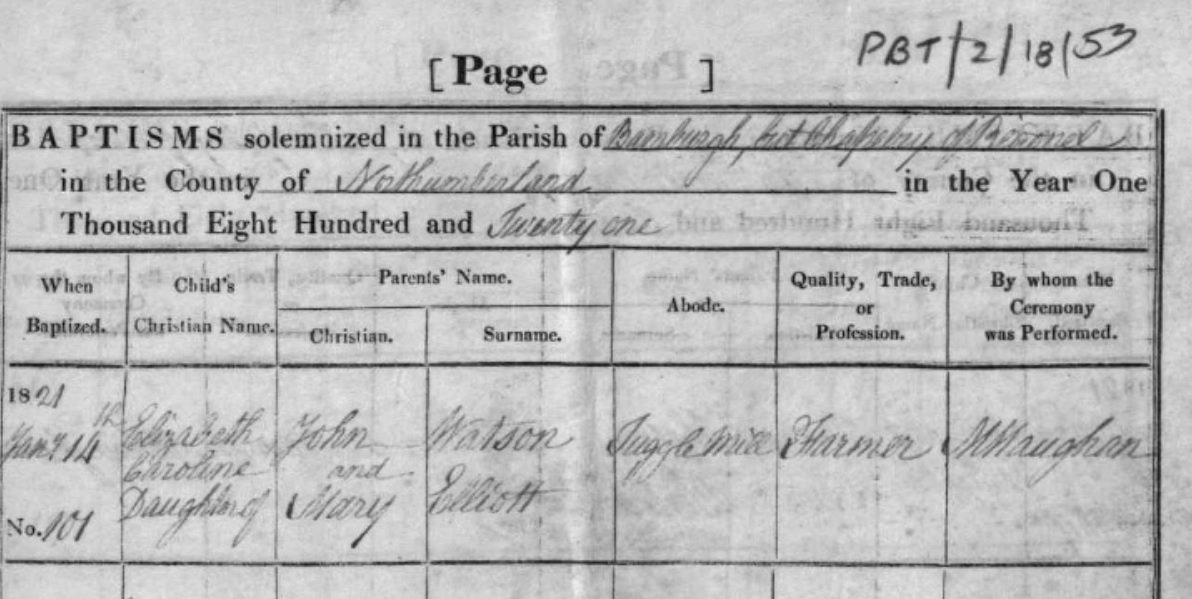
Birth record of Elizabeth Caroline Watson of 1821, wife of Henry James Cochrane.
The above U.K. Census of 1851, indicates Henry James Cochrane was working as a coal miner at the age of 29, was married to Elizabeth Caroline Watson age 30, and their son John was aged 2 months. It is likely Henry James Cochrane moved away from his original home and district of Bamburgh, to start a new life with his wife Elizabeth to Embelton, which is just over 10 miles south of his birthplace of Bamburgh. It is believed six years after this Census, Henry James Cochrane and his family emigrated to Australia, however the inability to confirm a number of details, backs up his nominated pseudonym of being a bit of a "Mystery Man".
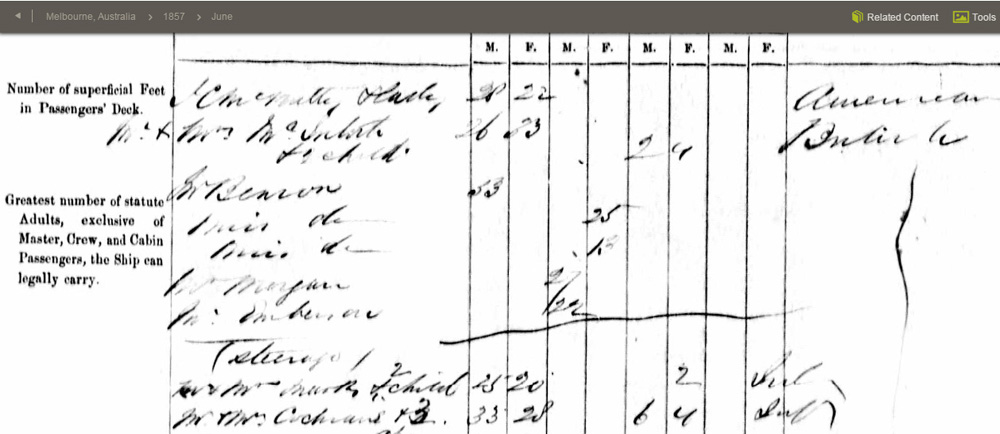
So after numerous hours, actually a days duration of researching Victorian Passenger lists, taking into account the Cochrane family records which often had an unusually high amount of age discrepancies and spelling errors in them, and, following the age-old process of logical elimination, the only possible located State record for Henry James Cochrane that is probable, and comes close, is shown below.
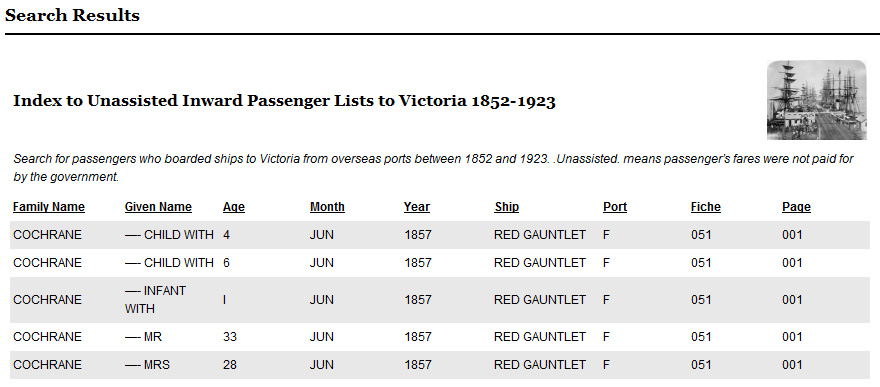
The most likely located emigration record found for Henry James Cochrane and family probably onboard the Red Gauntlet in 1857.
This particular Voyage of the Red Gauntlet commenced from Plymouth on 21 March 1857, continued to Liverpool and picked up over 300 hundred emigrating passengers there, and docked at New York in the United States, where a Mr and Mrs Cochrane and family embarked.
This same Passenger List record of June 1857 from New York, showed a Mr and Mrs Cochrane, and 3 children, the youngest an infant daughter, all embarked to travel to Hobsons Bay in Melbourne, Victoria. This record indicates the correct age of 33 in 1857 for Henry James Cochrane, the exact ages of their two sons John born 1851 aged 6 in 1857, and his brother Robert born in 1853 aged 4, and a Mrs Cochrane age 28, and according to the handwritten record, including an infant daughter under 1 year old. Looking at Elizabeth Caroline Watson's details, she was baptised in Northumberland in Jan 1821, probably born in 1820, so her approximate age in 1857 would have been 36 and not 28 as shown here.
This point also raises some relevant questions -
Did Elizabeth Caroline Cochrane nee Watson lie about her age at the docks, or maybe its another simple notation error. If Elizabeth Caroline Cochrane nee Watson did come with Henry James, why is there no birth record of the infant daughter in the U.K.?
OR
Could Henry James Cochrane have remarried a relation of his first wife, maybe a elder sister or cousin called Mary Watson, perhaps after the Elizabeth Caroline Cochrane nee Watson may have passed away in England?
Both these possibilities could be true, as there has been no official records of Elizabeth Caroline Cochrane nee Watson's death found in the UK or Australia. To add a touch of intrigue, the Victorian death record of the eldest son John Cochrane lists his mother as Mary Watson, and, and even more intriguing the other son Robert's death record, simply denotes "Watson" as mother. This baffling mystery may never be solved or proven, yet it is most likely Henry James Cochrane and his family did travel to Melbourne via New York USA, on board the Red Gauntlet in 1857.
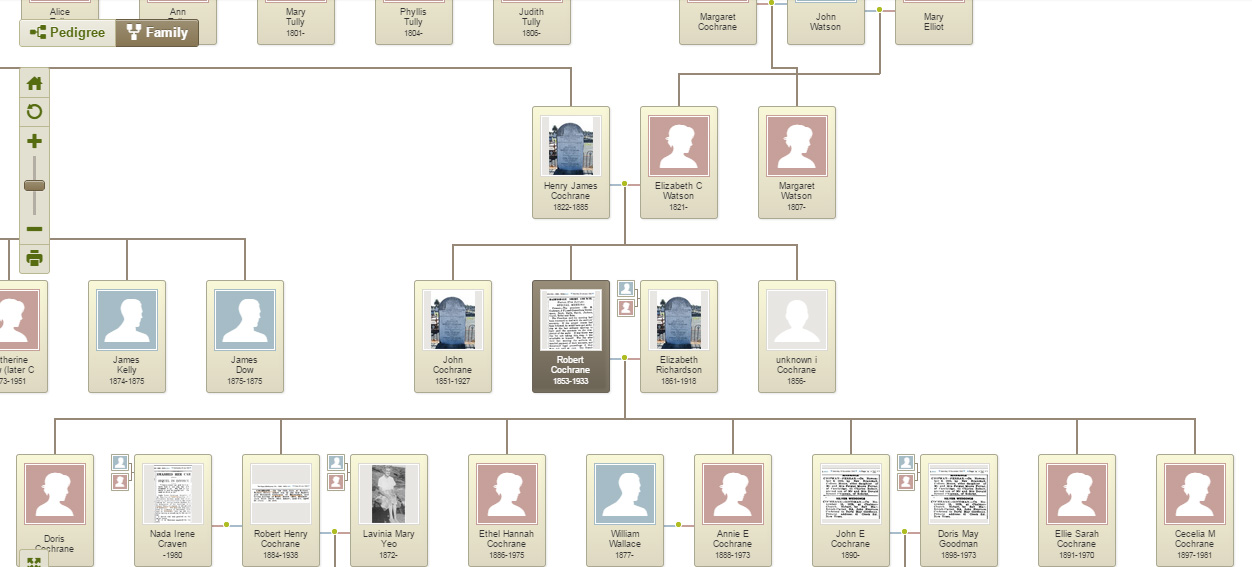
Family timeline of Henry James Cochrane, his wife, children and grandchildren per ancestry.com.
Regardless of the doubt surrounding Henry James Cochrane's emigration to Australia, the only other located facts relating directly to Henry, are from his death notice and record, basically his occupation of Hop Grower, and the date and place of death, being 12 Mar 1884 in Eastwood, near Bairnsdale. There have been no records found, of Henry having any more children in Australia, no Gold Mining Shareholdings, no land or title ownership on Parish maps, nor any newspaper cuttings from the 1860s till 1884 of his arrival or any activities to the Bairnsdale region.
Death Record details
Henry James Cochrane age 63
Late Residence: Bairnsdale
Burial Date: 12 Mar 1884 Bairnsdale Cemetery
Section: Roman Catholic
Register Number: 69
Occupation: Hop Grower
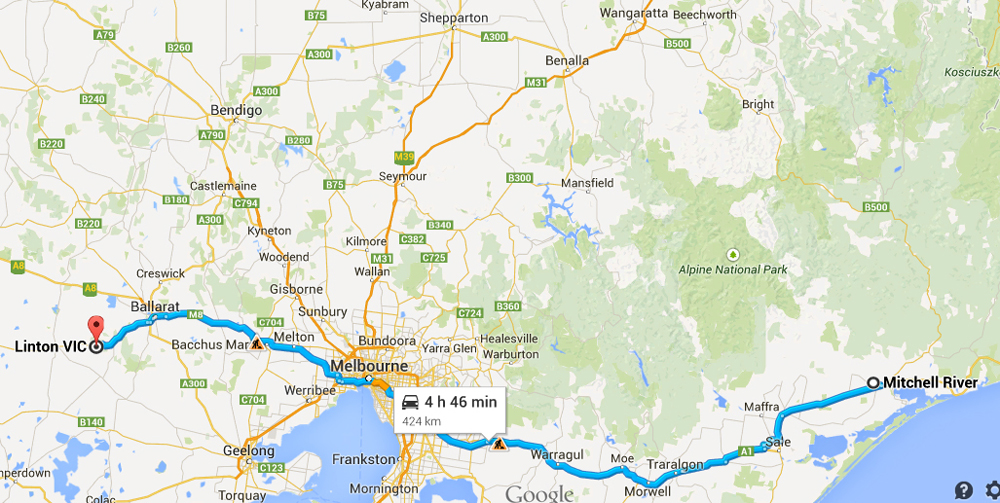
A modern Google map showing the Mitchell River at Eastwood near Bairnsdale in East Gippsland, in relation to Hugh Taylor Cochrane's hometown of Linton, on the Ballarat Gold Fields.
Eastwood, where Henry James Cochrane passed away, was originally the first land selection of Alfred Howitt in 1865, who is better known as the explorer who traced the ill-fated Burke and Wills outback expedition, back in 1860. Eastwood, was the name of Howitt's homestead, and nowadays located in the immediate vicinity of Lucknow Primary School, near the Mitchell River Backwater, just north of Bairnsdale township.
It is logical to reason this property at Eastwood where Henry James Cochrane died, may have been where Henry James and his two sons originally settled when they first came to East Gippsland, however searches of old neighbouring Parish Maps of Wy Yung, Wuk Wuk, Sarsfield, Moormurng, Lucknow, Bullumwaal, Goon Nure and even Bairnsdale, failed to find a Henry J Cochrane as a title holder.
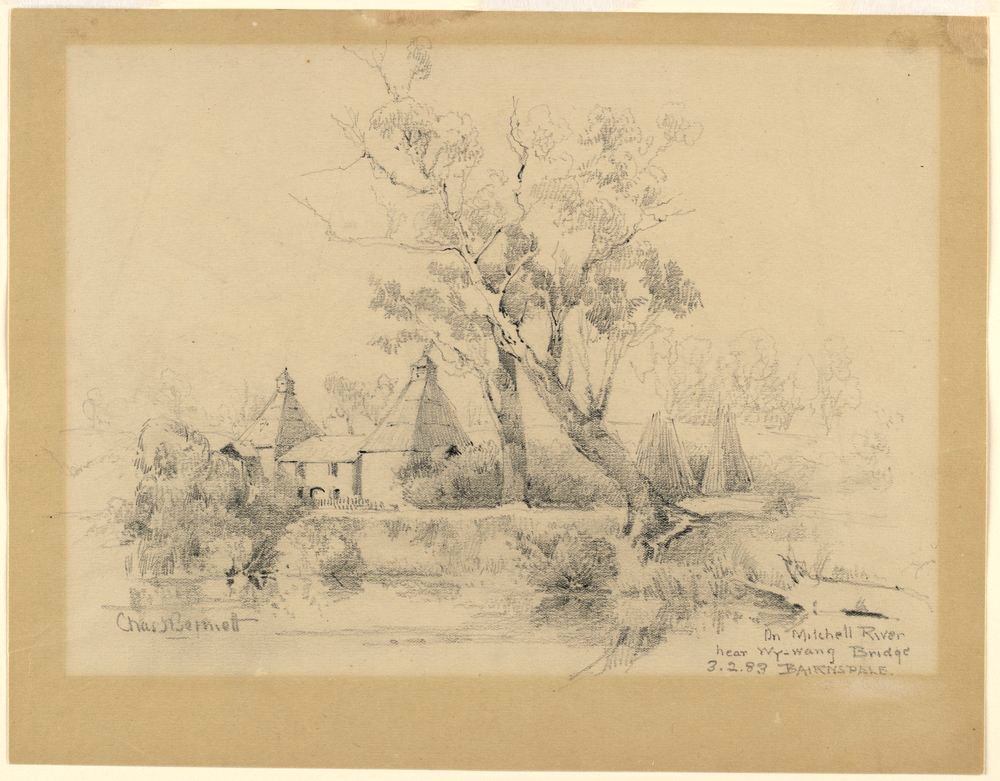
A serene setting of Hop kilns at Wy Yung on the Mitchell River, sketched by Charles S Bennett in 1883. Note the two stacks of long poles used to stake the Hops about 8 to 10 feet off the ground - Courtesy State Library of Victoria.
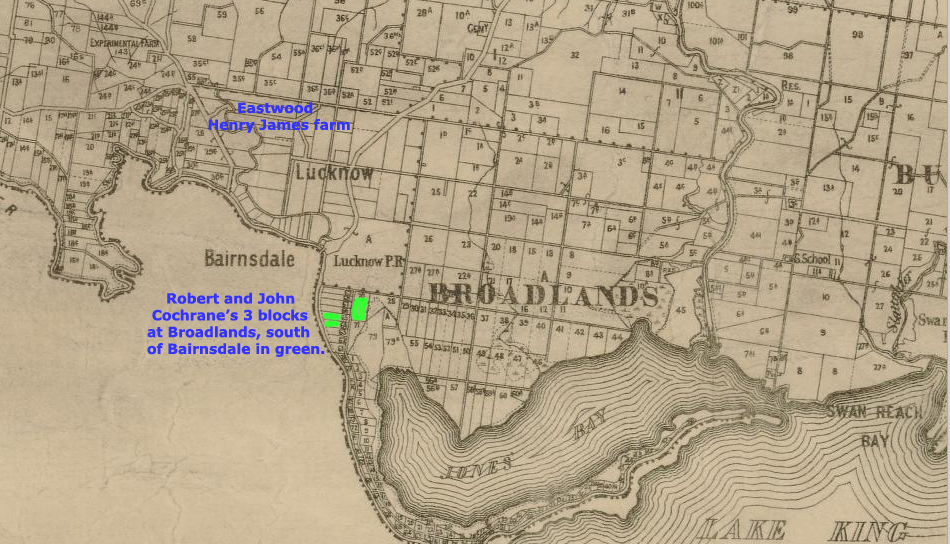
1880s Parish Map showing location of Henry James and his sons land, at Eastwood and Broadlands respectively
- Map from State Library of Victoria.
Henry James and Elizabeth Cochrane had two sons, John and Robert who followed in their father's footsteps, and became major Hop growers on their own farm south of Bairnsdale. They were well established in the industry, and the local community, when their father passed away in 1884.
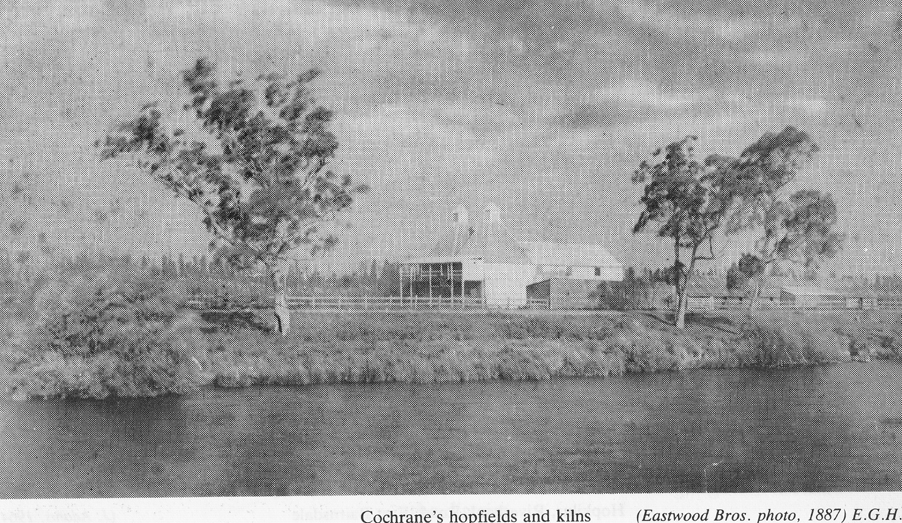
Robert and John Cochrane's Hop Kilns. Courtesy Bairnsdale Shire book "Path among the years".
It is most likely this photo was taken from the Mitchell River adjacent to one of the two blocks on the left highlighted in green, in the Map of Broadlands above.
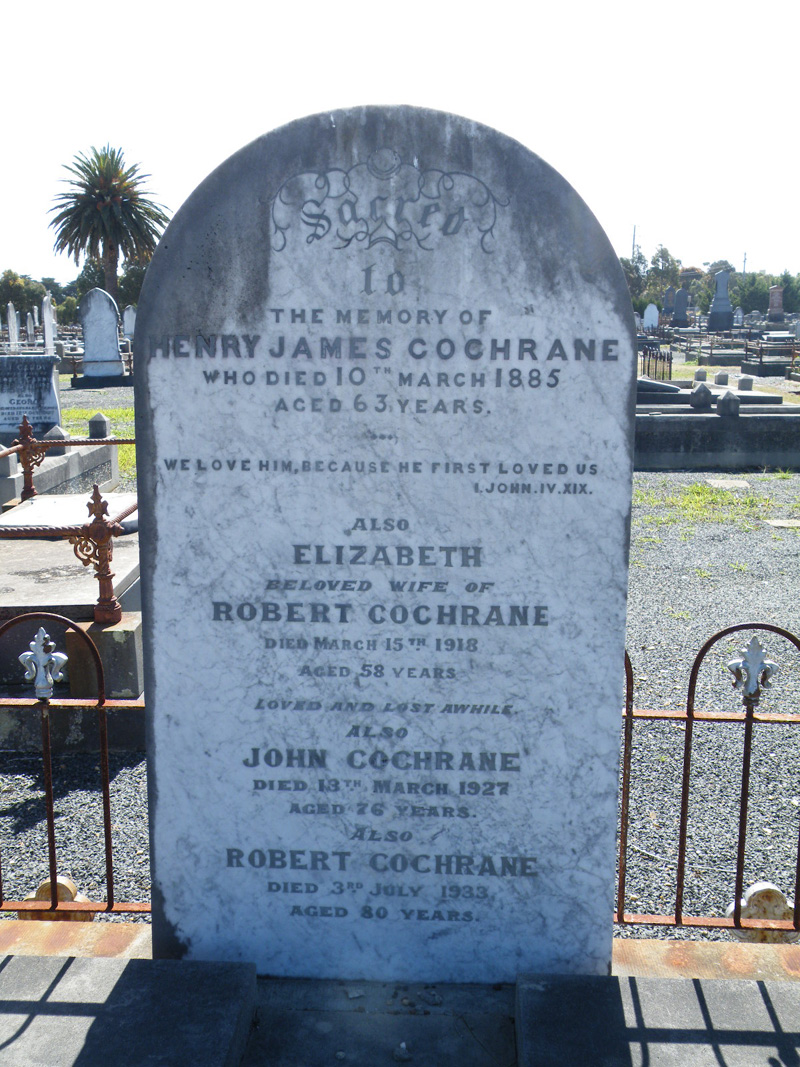
Headstone of Henry James Cochrane, daughter-in-law Elizabeth Cochrane nee Richardson, and his two sons born in Northumberland UK., John Cochrane born in 1851, and Robert Cochrane, born in 1853. Kindly note Henry James Cochrane's record state he died in 1884 and not 1885 as on this headstone.
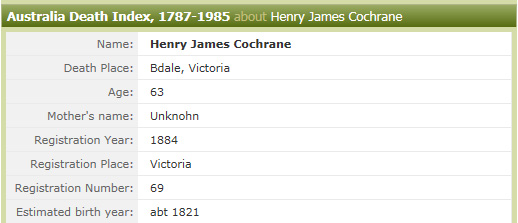
What does stand out as rather unusual, is that the informant of this Death Certificate, probably Henry James Cochrane's son John or Robert, did not know their father's parents names, for notification in this formal and official process. It also stands out that on the death record of eldest son John Cochrane, his mother is noted as "Mary Watson", and not Henry James first noted wife Elizabeth Caroline Watson, and, on the second son Robert Cochrane's death record, his mother is registered as simply "Watson". An attempt has been made to purchase the formal Victorian death record of Henry James Cochrane , in order to clarify who was the informant, probably either son John or Robert, without success. The above points imply Henry James Cochrane did not reveal his parents name to his children for some unknown reason, and the proper name of his first known wife Elizabeth Caroline Watson, was not mentioned by either informants of sons John and Roberts deaths.
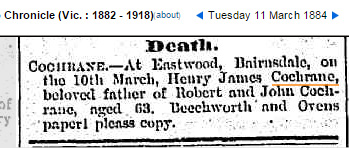
Death notice of Henry James Cochrane of March 1884, at Eastwood, about 2 miles North of Bairnsdale.
Due to the fact Henry James Cochrane and Elizabeth Caroline Watson's second son Robert, married our Elizabeth Richardson in 1881, it makes sense to provide a brief overview of these two brothers' lives in the Bairnsdale region, from the reasonable amount of relevant information that is currently available.

JOHN COCHRANE, born 1851 at Embelton U.K.
The earliest located record of John Cochrane, the first born son of Henry James Cochrane and his wife Elizabeth Caroline Watson, is the following U.K. census of 1851. Research indicates John Cochrane never married, but was buried with his sister-in-law Elizabeth Richardson, his brother Robert, and their father Henry James Cochrane at Bairnsdale Cemetery, when John passed away in 1933.

U.K. Census of 1851, showing Henry James Cochrane, employed as a local coal miner, his wife Elizabeth Caroline Watson, and their first son John aged 2 months born at Embelton, about 10 miles south of Henry James Cochrane's original hometown of Bamburgh, northern U.K..
It would seem that John Cochrane and his younger brother Robert Cochrane were quite close in many ways, both in the fields of business, community, and sports activities, however it seems John may have been the quieter and less out-spoken of the two. It seems a little unusual, the business name they chose in such traditional times, had the initials of the younger brother first, ie. R. & J. Cochrane, and not the other way around. From available old newspaper resources a researcher may gather John and brother Robert were both very social and community minded individuals.
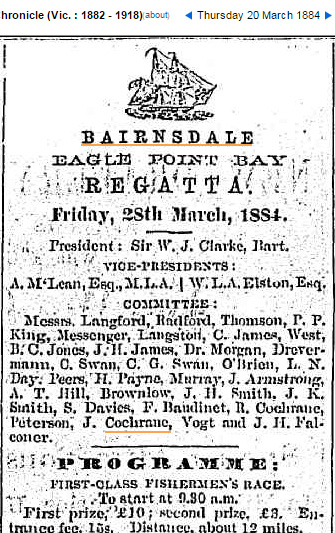
John and Robert Cochrane noted as Committee members of the local Eagle Point Bay Regatta Committee in 1884, an annual event held on the western edge of Lake King, only a few miles south of Robert and John's farm at Broadlands.
It is not clear exactly when or even why Henry James' sons John and Robert began their Hop farm operations in the Broadlands Parish south of Bairnsdale, but going by the scale of their farming operation and promotions in 1880, one may gather it may have been established in the early 1870s. owever old time Parish maps and further newspaper cuttings, confirm the following details about their farm are quite accurate. Lots 64, 65, & 70 in the Broadlands Parish listed as the Cochrane's hop farm properties in their 1894 assests list, are shown below on the 1889 Parish map of Broadlands, the Roman Numeral equivelants, being 64 = LXIV @ 21.23 acres, 65 = LXV @ 23 acres, and 70 = LXX @ 51.2 acres, making a total of over 96 acres. Careful review of this 1889 and other Parish regional maps indicate the Cochrane Bros Hops farms were located about 2 and a half miles south of Bairnsdale, about 20 chains (400 metres) from the eastern bank of the Mitchell River. Looking at other maps of this time period and region, shows easements up to 20 chains from the Mitchell River bank to individual property boundaries were very commonplace.
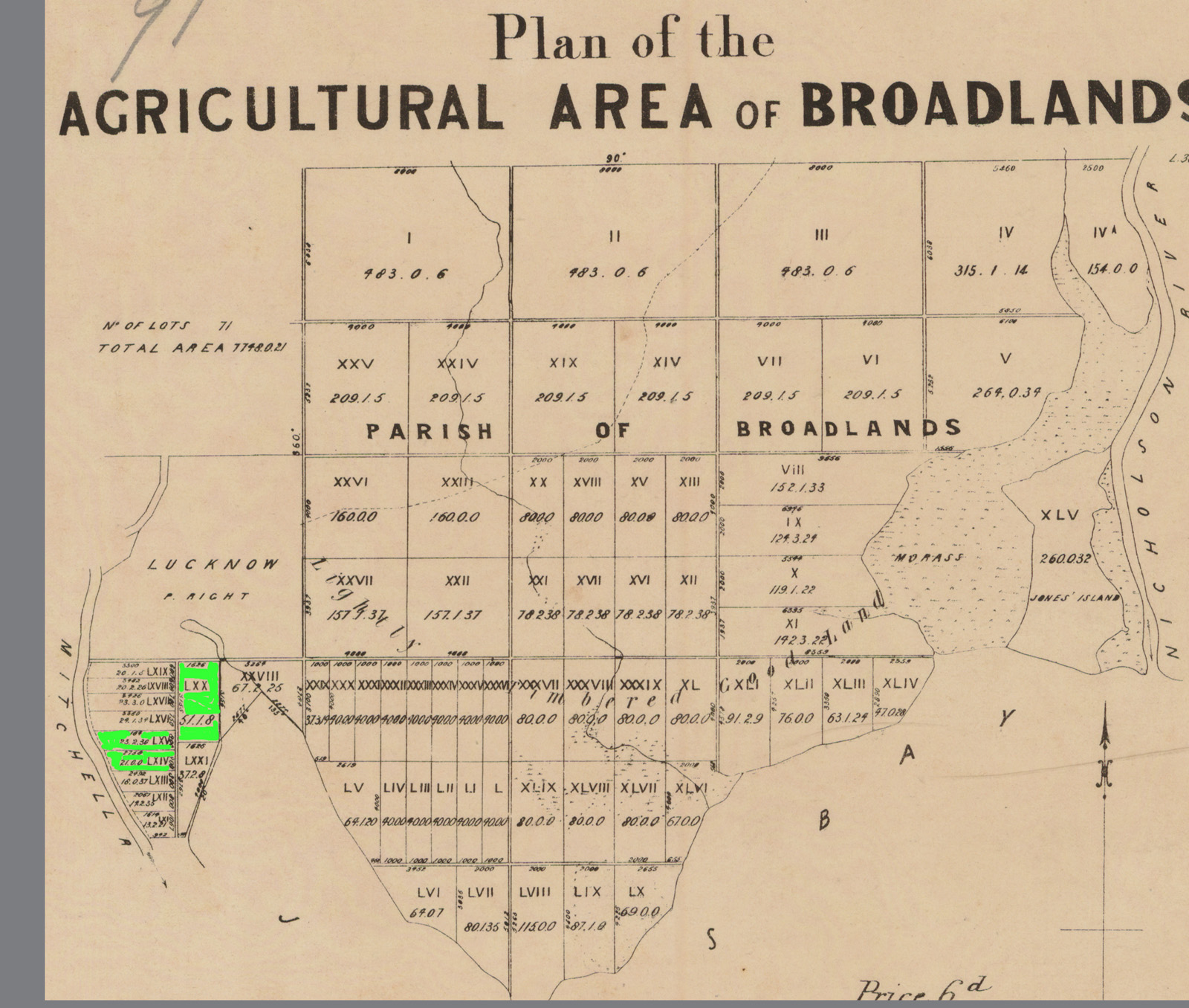
1889 Parish Map of Broadlands near Bairnsdale - the Cochrane Brother's farms are highlighted in green.
It is also worth mentioning this Cochrane family branch were not alone from a broader family point of view, during such an era when many practical, personal, and social aspects of life, often depended heavily upon nearby support and practical assistance. Through the marriage of Robert Cochrane to Elizabeth Richardson, they had numerous family members within very close proximity up and down the Mitchell River near Bairnsdale, being namely William and Catherine Calvert, John Russell and Jane calvert, Hugh and Paulena Coulson, Joseph and Sarah Race, and numerous other in-laws. A little further afield, were John and Hannah plus Emmerson and Ellen Richardson and the Viponds at Swan Reach, Joseph and Mary Liddell at Nicholson, Thomas Henry and Margaret Cunningham at Tambo Upper, and dozens of other cousins and relations by marriage to socialize with and call on for help if needed. Some even played cricket together in the 1880s.
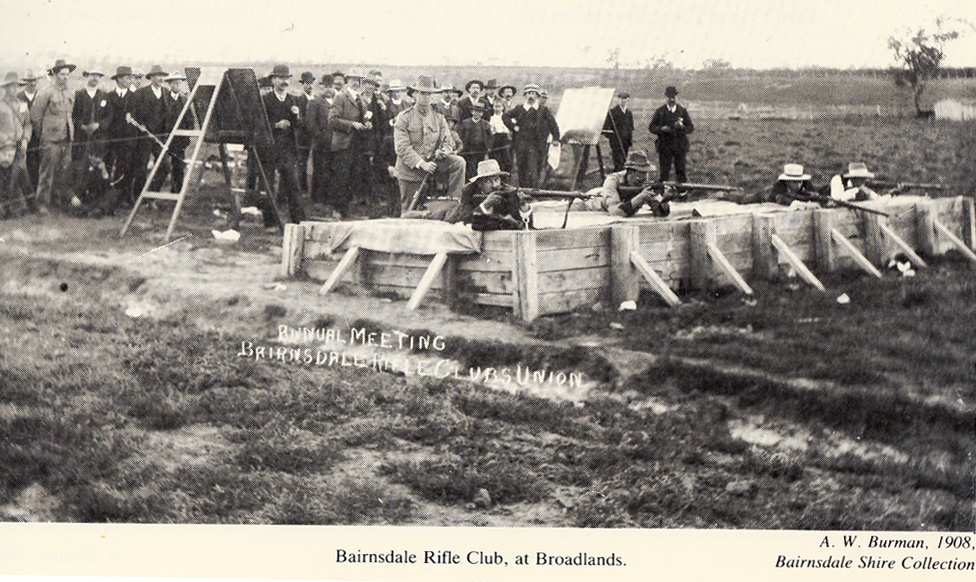
Bairnsdale Rifle Club meet at Robert and John Cochrane's property at Broadwood 1908.
Courtesy Bairnsdale Shire book "Path among the years".
Numerous references indicate John's joint interests with Robert in their Hop growing business was a high priority of his life, yet John was also a member of the Eagle Point Regatta Committee from 1882 - 1884, found to be a long standing member of the Bairnsdale Racing Club throughout the 1880s, was a starring batsman for the Bairnsdale Cricket Club, and also was known to be a member of the Bairnsdale Rifle Club in in 1885, and became the Rifle Club President in 1894. Although John Cochrane history of being quite involved in a number of local clubs and activities, one may gather he was not as keen in regional politics or similar high profile roles in the local community, as his brother Robert appeared to relish in.
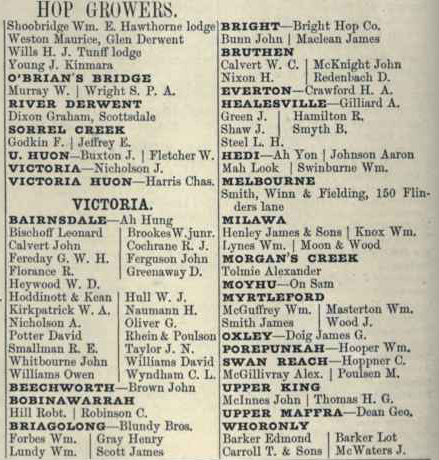
Full details of above image re Bairnsdale business directory are unknown - Courtesy mocavo.com
Kindly note - The above Bairnsdale listing of R. J. Cochrane most likely refers to Robert and John Cochrane as major Hop Growers of the region. W. C. Calvert of Bruthen shown here was actually a relation by marriage to Elizabeth Cochrane nee Richardson via William Coulson Calvert, son of John Russell Calvert & Jane Coulson.
An in depth review of newspaper cuttings of the time, suggests Robert and John were well recognised and established in the growing and marketing subtantial amounts of Hops on the banks of the Mitchell River Flats at Broadlands, from the 1870s right through to at least the 1910s. On a more personal basis, they were keen and successful sportsmen on the local cricket scene, very community minded, and were members of the local Bairnsdale Horse Racing Club and Rifle Club.
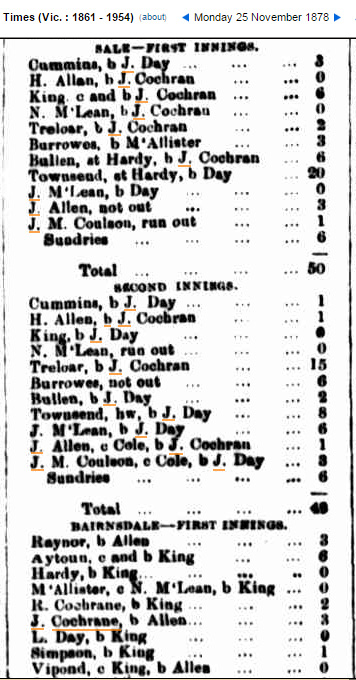
Newspaper cutting from the Gippsland Times from November 1878, listing John Cochrane as the star bowler of the family, & Robert getting an odd wicket.
Their Vipond team mate, was probably John Vipond, a relation of Robert's wife Elizabeth Richardson, from Nicholson or Swan Reach, and renowned for playing in the local 1876 Challenger Cup, and with the Bairnsdale Cricket Club. Later news reports of a big cricket match at Omeo, clearly give us an impression Robert and John had very diferent skills, as Robert was a very good cricket batsman, whereas John seemed not so hot at the crease, on this occasion in Feb of 1885 at Omeo.
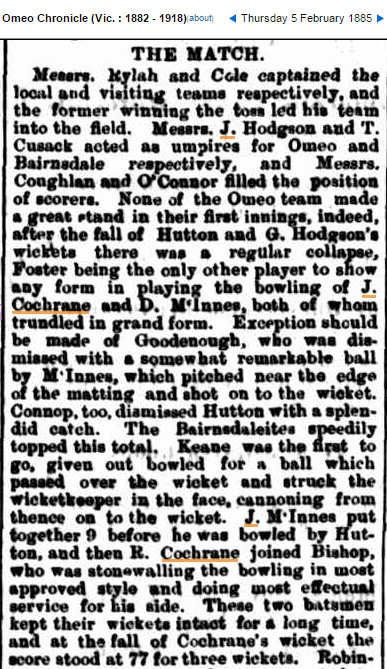

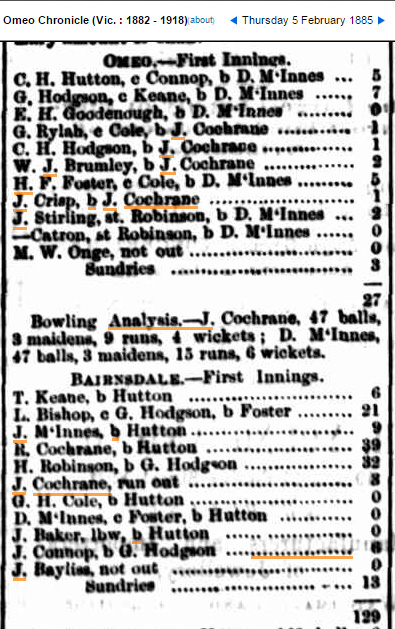
There are numerous references to brothers John and Robert Cochrane's business ventures, which formally mentions them as "R and J Cochrane", in the local Hops Industry, both before and after the death of their father Henry James Cochrane in 1885. Being a member of the local Horse Racing Club in this district was also a major interest of the their relatives on the Richardson side, the Calverts from Mossiface, and both Robert and John Cochrane were members of this Club too.
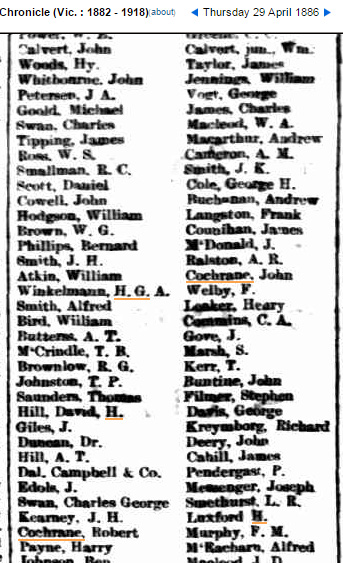
The Cochrane Brothers were members of the Bairnsdale Horse Racing Club in 1886, as was John Russell Calvert, and his son William Calvert, John Russell being the owner of his own race track at Mossiface Park not far from Bruthen.
Perusal of the next few articles, the first article being in four parts, indicates the Cochrane Bros were quite inventive and innovative with both their hands on day-to-day logistics on the farm, as well as marketing the Hops they produced. The four sections of the following in depth article about major pumping and irrigation systems in different parts of Victoria in the 1880s, provides the reader with a very detailed overview of the quite unique design of the Cochrane Bros watering system, hops operation, and practical circumstances on the Mitchell River. As a matter of interest, this is only an extract of the original much larger article which compares another style of large scale pumping setup from Bacchus Marsh in Victoria, about 330 kilometers West of Bairnsdale.
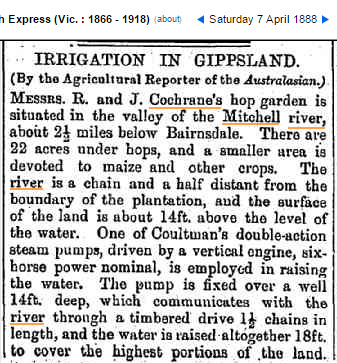
Report of the Cochrane Bros farm and pumping operation - Part 1. Bacchus Marsh Express 7th Apr 1888
The Coltman pump mentioned here was probably disrtribruted by Edwin Coltman of Latrobe St East Melbourne. The Argus newspaper of 10 Nov 1876, describes this pump in a machinery show as,
"AGRICULTURAL SOCIETY'S SHOW. THE MECHANICAL SECTIONS
agricultural machinery in the southern hemi
sphere should be made in the show grounds
of the National Agricultural Society of Vic
toria. Since the society held its first show
ment has annually increased in extent, and
first allotted to it is found to afford insuffi
cient room for the visitors conveniently to
inspect the exhibits.
Inside the southern
There are 22 engines in this line, and
another score or so large and small
horizontal, direct acting and others scat
which, by the way, there are 50. There are
coming more common, and tall wool presses,
from various depths, catch the eye of the dis
tant observer. In the lower part of the
grounds Mr Coltman, of Latrobe street, is
pulsometors,"
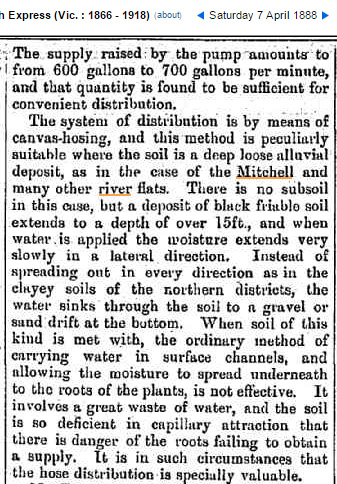
Report of the Cochrane Bros farm and pumping operation - Part 2. Bacchus Marsh Express 7th Apr 1888
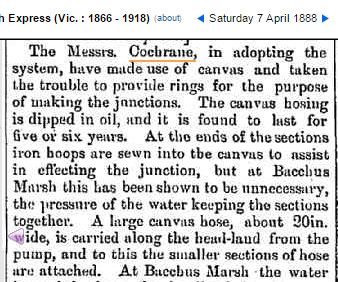
Report of the Cochrane Bros farm and pumping operation - Part 3. Bacchus Marsh Express 7th Apr 1888
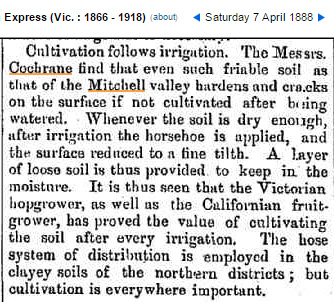
Report of the Cochrane Bros farm and pumping operation - Part 4. Bacchus Marsh Express 7th Apr 1888
From the following newspaper reports, it would seem after their father Henry James Cochrane passed away in 1885, these two sons continued to promote their Hop growing ventures into the 1890s, however they underwent major financial problems, keeping their business in a profitable state.
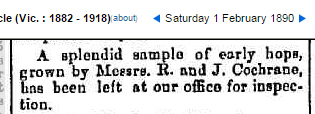
"A splendid sample of early hops", on display presumabley for the Bairnsdale Shire or market in 1890.

Very entreprenaurial produce promotion of the time - Export of sample hops to England.
John Russell Calvert, Elizabeth Richardson's relation from Mossiface is known to have initiated these sample exports for the marketplace in England, We do not know if the Calvert and Cochrane growers joined forces in this very innovative exercise, however due to Hop prices in the U.K. at that time, it turned out to be a non-viable venture.

Hops, pickers, and wagons at John Russell Calvert's farm at Mossiface.
Courtesy http://arrow.monash.edu.au/hdl/1959.1/70354
Written permission for reuse - Federation University Centre for Gippsland Studies, Monash University Research Repository.
The above photo of the 1890s at the Calvert's Hop farm, portrays the labour intensive aspects of growing hop crops on very tall hop poles, picking the crop, packing and pressing the hops into bags, ready for cartage by horses for storage, all done in the paddock. We know that Robert and John Cochrane had 20,000 hop poles and 40 acres of hops planted in 1894 after the floods, so they would have been regarded as very serious Hop Growers, yet maybe unfortunate, or maybe not so clever choosing very flood prone land on the bank of the Mitchell River.
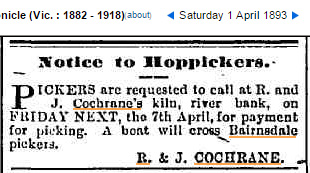
Payment notiication by the Cochrane Brothers for their pickers of the 1892-1893 Hop crop.
From this advert we can assume R & J Cochrane were in the position to pay their pickers for past completed work. The mention of a "river bank" and a "boat" tends to imply the farm may have been over the other side of the Mitchell River from Bairnsdale, and they were prepared to supply a boat ride in order pickers could collect payment for work done earlier.
Also it should be mentioned that the younger brother Robert, held a number of highly regarded senior positions in local Government and various community groups at this point in time. In addition to being the Bairnsdale Shire President and a Justice of the Peace, one of these positions was actually as a Commissioner of the Bairnsdale Water Supply and Irrigation Trust in 1893, as he was most likely well respected resulting from his wealth of experience in local irrigation matters. The Trust had been involved in overseeing the building of a large weir across the Mitchell River, in order to address a long standing record of serious floods near bairnsdale, and also to help regulate the town's water supply.
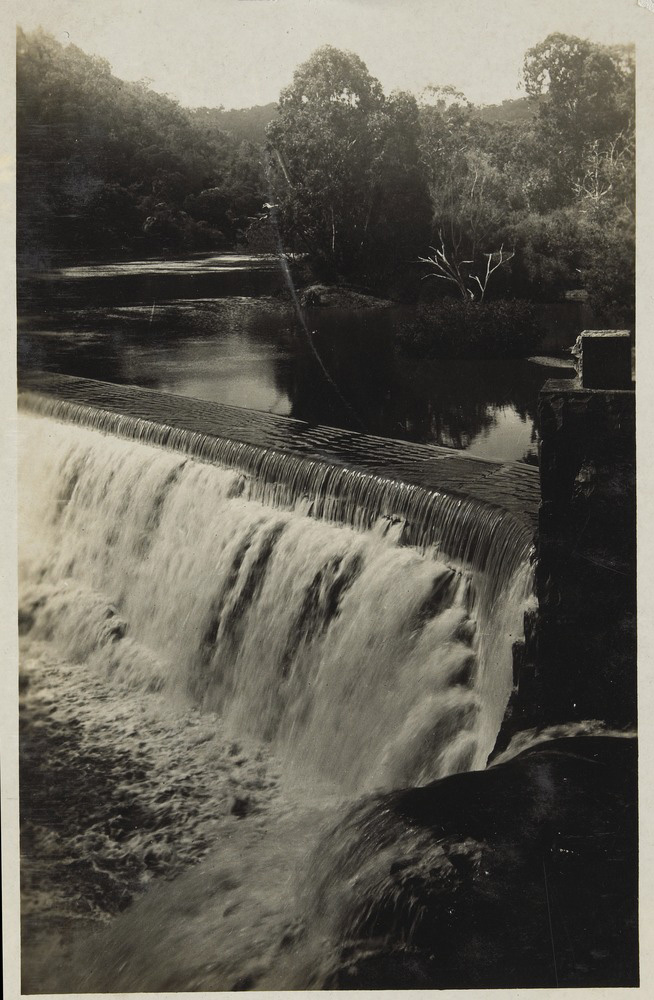
The Mitchell River Weir intended to control floodwater, pictured much later in a flood year of 1917 - Courtesy State Library of Victoria.
It does seem rather ironic in a way, that this Cochrane clan were extremely practical, intelligant, adaptable, and inventive, and well aware as to life on the Mitchell River Flats, however it does create some doubts, considering the long time record of huge floods there from 1870, as experienced by their Calvert and Coulson in-laws, who lived only about 3 miles up river.
According to Wikipedia -
"The Mitchell river flats were always prone to flooding and 1891 bore witness to the flood that was only second in extent to the great floods of 1870. The biggest floods recorded were in 1893-94 with them being 76mm higher than the 1870 water levels. All floods caused the township great suffering with loss of life, infrastructure and crops.
The flooding that occurred in the 1893-94 was notable for the gallantry of Patrick Piggott and George Brooks who both worked to rescue people. However, on their last trip their boat tipped as they moored it and both men were swept into the river and drowned. A witness remonstrated that; "...to the very last, they fought bravely for their lives against fearful odds. Both men are remembered upon a marble tablet installed at the Mechanics’ Hall (Ref - The Bairnsdale Library)".
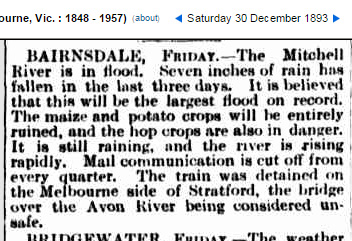
This widely experienced family, are shown to be highly regarded as very knowledgable in irrigation and water flow matters, yet they chose land in a renowned flood prone region of East Gippsland. Little did R & J Cochrane know, that after paying their pickers earlier in April of 1893, that at the end of the same year and into 1894, the floods on the Mitchell River flats where their farm was located, would prove quite devastating to their annual crop, plus have disastrous effects to their long term financial future. Despite the devastating results of the floods, life continued on in many ways, including their interests in rifle shooting.
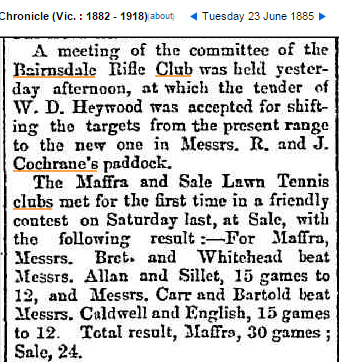

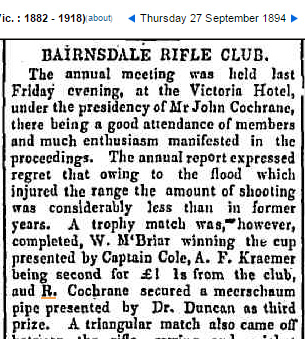
John Cochrane, President of the Bairnsdale Rile Club in 1894 - The Cochranes provided the club's Rifle Range venue on their property, regardless of their hard financial times, being basically bankrupt, they still contribute to the local community where they could.
Next is a very detailed listing, in two parts, of farming and stock assets, to be sold to recoup financial losses from floods.
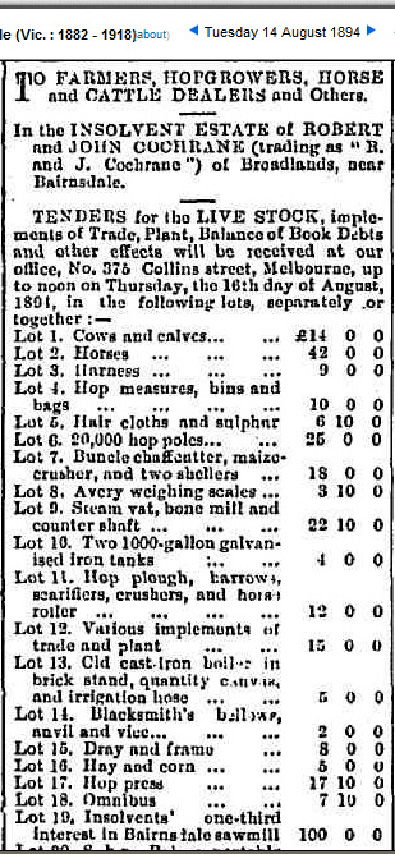
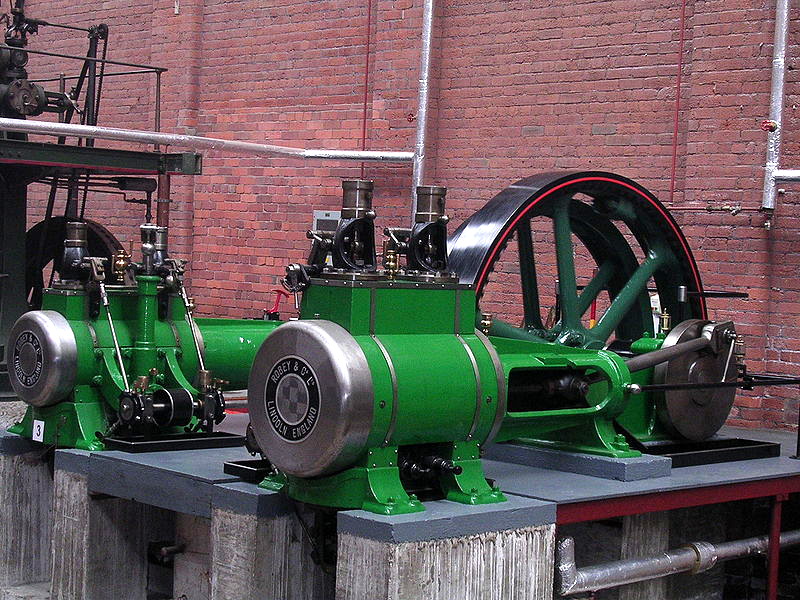
Two English made Robey Engines similar to one on the Cochrane Bros assets list. Courtesy Bolton Museum / Wikipedia.
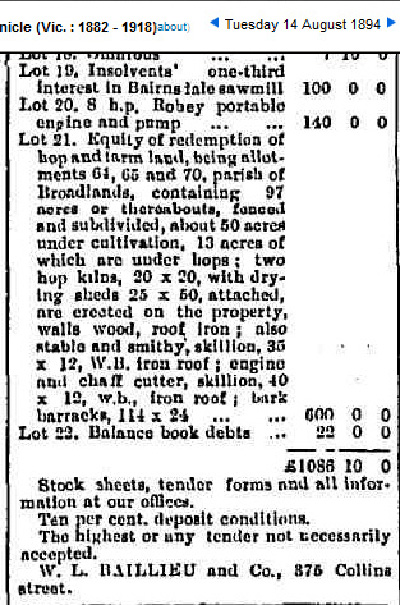
During their time on the arm at Broadlands, Robert and John Cochrane amassed a broad array of equipment, livestock, and assets, uncluding a third share worth 100 pounds, in a timber mill in Bairndsale.
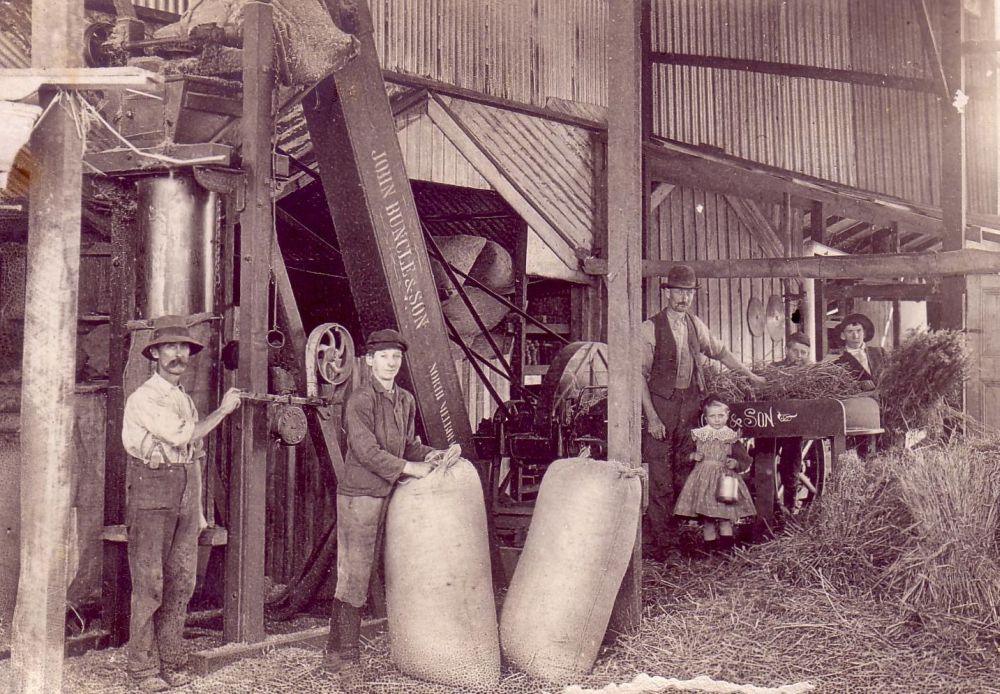
A commercial steam driven Buncle chaff cutter owned by Charles Wilkinson of Preston in Melbourne in 1906. The Buncle chaff cutter as owned by the Cochrane Bros per the above list, may or may not have been as large as the one pictured here, as Buncle made range of sizes, from small portable units for use in paddocks and upward. Courtesy Oz Wrenches.
On the 27th July 1894, their financial predicament was described as "Losses from floods and land depreciation values, and adverse judgement, resulting with liabilities - Debts £7164 6s 6d ; assets £3498 19s 3d ; deficiency, £3655 7s 3d. , according to Bairnsdale solicitor Mr Kirkpatrick".
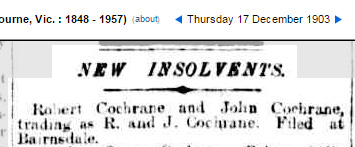
R & J Cochrane ran out of cash flow again for their business ventures in 1903 - seems like they haven't yet recovered from the disastrous 1893 floods. However going by the Certificate of Discharge notice shown below, the Cochrane's finally paid their debts and mortgage after 15 years of financial debts.
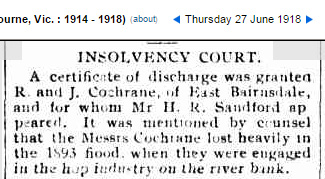
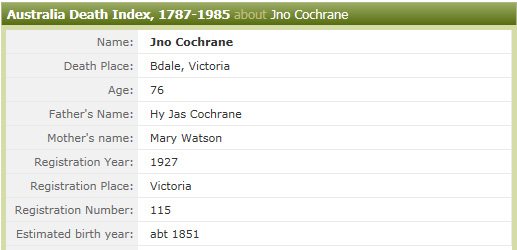
Death record of John Cochrane, eldest son of Henry James Cochrane and Mary Watson of Bamburgh, U.K.

ROBERT COCHRANE, born 1853 at Fleetham via Bamburgh U.K.
According to his birth record, Robert's parents were living at Fleetham, about 6 miles south of Bamburgh, and his father Henry James cochrane was noted as working as a labourer. Robert Cochrane was baptised on the 7th Aug 1853, and this event is registered at St Pauls North Sunderland as Baptism number 623.
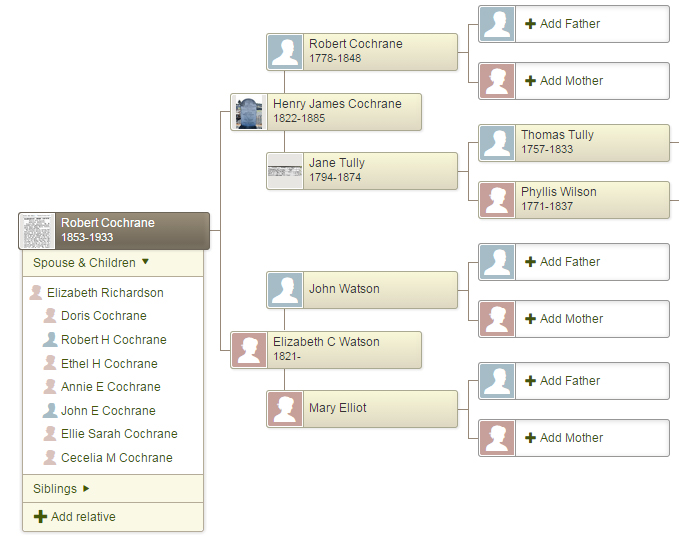
Timeline back to Robert Cochrane from Eglington UK, showing the Richardson / Cochrane Australian Connection, with the marriage of grandson Henry James Cochrane to Elizabeth Richardson.
From Birth and Gold Mine records, we know the Richardson family, with Elizabeth being in her teenage years, spent most of the 1860s in the areas of Ballarat and Castlemaine, mainly at Smythesdale, Ballarat East, Campbells Creek, and Cambrian Hill, and also Fryerstown. Considering all five of the Cochrane brothers whom emigrated to Victoria, tended to move around the state of Victoria quite a deal, focussing on Ballarat area at first, and some moved about 350 kilometres further away to the Beechworth district.
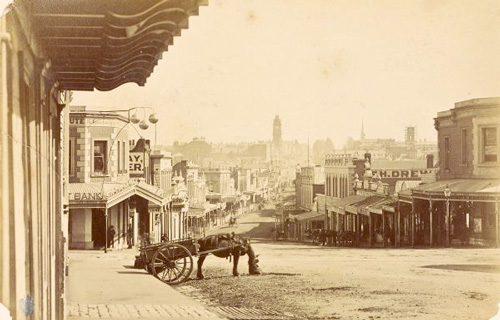
A later view from Ballarat East towards Ballarat, in the 1880s.
During the Cochrane's time near Ballarat, they were known to have been around this period at Smythesdale and nearby Linton, Ballarat East, Bulldog, and Heatcote via Bendigo. It is not possible to ascertain where Robert Cochrane and Elizabeth Richardson met and courted, but it's highly probable it was somewhere near Ballarat Gold fields, or maybe even near Bairnsdale in East Gippsland. It has been ascertained Henry James, Robert, and John Cochrane were well and truley established Hop Growers on the Mitchell River in the 1870s, and were good business men when it came to promoting their produce on an International level in Victoria's capital city of Melbourne in 1880.

Robert and John's serious marketing efforts, putting their Hops on exhibition in Melbourne at an International expo in 1880.
We have no realistic means of gauging how successful the Cochrane brothers display at this 1880 international exhibition was, however, the following year was quite a special one for Robert, and his fiancee Elizabeth Richardson, as they were married on the 25th Apr 1881, at St James Church in Melbourne.

Marriage Certificate of Robert cochrane and Eizabeth Richardson in Melbourne in 1881.
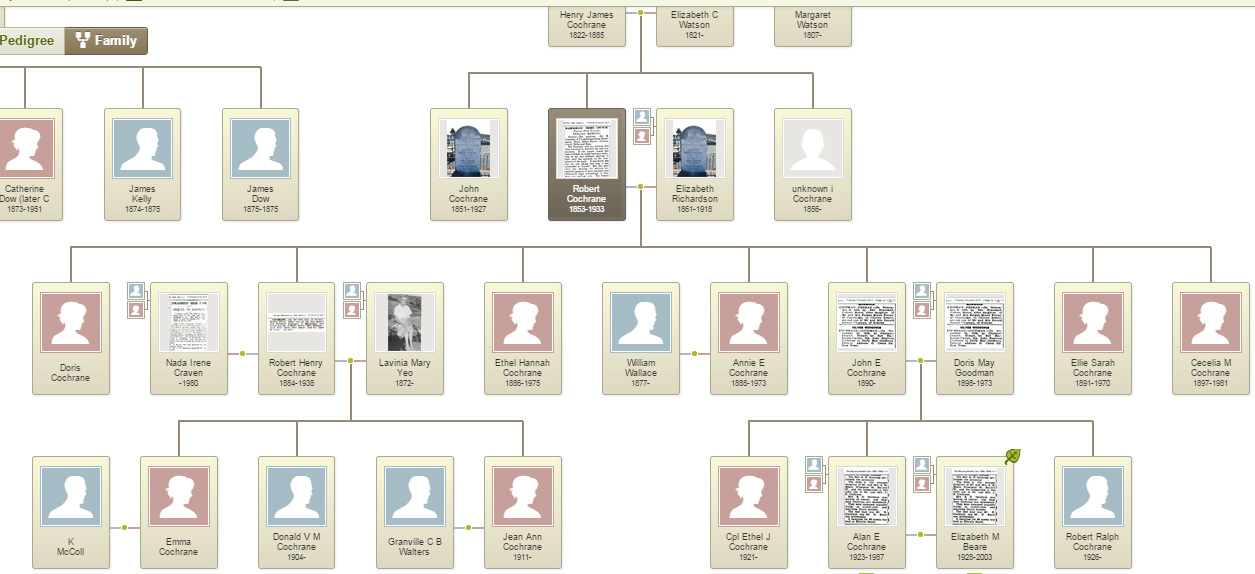
Like his elder brother John, Robert and newly wedded wife Elizabeth were highly regarded and respected community members. Courtesy of an advanced search in Trove NLA Newsapers regarding Robert Cochrane in the Bairnsdale region, it has been ascertained by over a few hundred references, Robert and Elizabeth Cochrane, were extremely active and heavily involved in local community groups and events. In 1883 Robert became a Councillor on the Bairnsdale Shire, and later became President of the Shire from 1892 - 1894 for the last two years of his service on the Council. Numerous articles in the Bairnsdale Advertiser and Tambo and Omeo Chronicle about a wide range of local issues and developmmental projects, indicates Robert was never afraid to raise questions about viability and accountability of major and minor public works, and he seemed quite tactful and fairly direct when making statements in meetings and to newspaper reporters.

Report of the barge launch by Mrs Elizabeth Cochrane, on the Mitchell River in 1883.
As the wife of a local Councillor, Elizabeth Cochrane nee Richardson, was invited to launch the first of three new barges on the Mitchell River, built by Mr Gibson on the banks of the Mitchell River. These three barges were built for the Lakes Carrying Company, that was officially registered as a company on the 22nd day of March, 1883, also had a number of steamers built by Ericson in service in this area around this time. The Company's Ship Master James Bull, conducted a number of regular excursions from the Bairnsdale wharf up the Tambo River and to Lakes Entrance, on the Steamers Ariel and the Sarah, the return trip for the sum of 1 shilling.
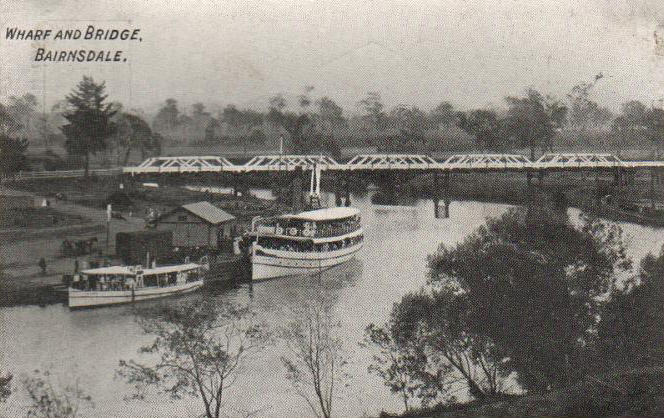
Photo of the Bairnsdale wharf with a ferry and barge-like vessell, date & details unknown from www.uknow.ga.
It is of noteworthy interest, Robert Cochrane also held other well respected and higly regarded, confirmed positions, including the approximate dates of -
Bairnsdale Shire councillor in 1883 and Shire President 1892 - 1894,
Eagle Point Bay Regatta Committee member in 1884,
Member Bairnsdale cricket Club from 1878 to 188?,
Member of the Bairnsdale Racing Club (horses) from 1886 and Vice President in 1891,
Commissioner of the Bairnsdale Water Supply and Irrigation Trust 1891 - 1893
President of the Bairnsdale Agricultural Society in 1893
General Manager of the Mitchell Lodge Manchester Unity Independent Order of Oddfellows 189? - 1897
and Justice of the Peace in the early 1890s - 1893.
Regardless of the formal positions Robert held in the 1880s and 1890s, life continued as usual as a Hop grower / primary producer. Should a stray bull jump a fence into your paddock, or, if you have a surplus of good quality hay to sell to other farmers in need, then neighbours and locals had to be made aware, with the Bairnsdale Advertiser and Tambo and Omeo Chronicle newspaper, being the means of conveying what was happening with the Cochrane brothers.
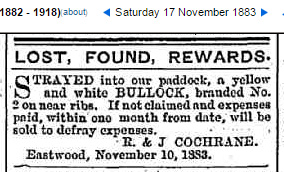
Part of life out the country - a stray bull on Robert and John Cochrane's hop farm at Eastwood in 1883.

Surplus hay for sale produced by the Cochrane Bros at the Eastwood farm in 1884.
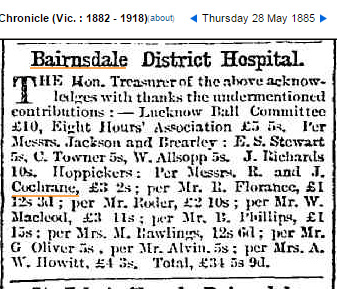

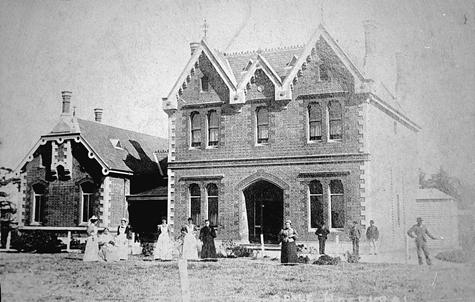
The Cochrane boys donated £3 2S (3 pounds 3 shillings - the equivelant of $7-60) to the Bairnsdale Hospital appeal in 1885 - the year after their father Henry James Cochrane passed away in Bairnsdale. At right is the Bairnsdale Hospital pictured in 1890 - Courtesy Museum victoria.
While still only a few years into the position of Councillor of the Bairnsdale Shire, Robert Cochrane participated in the rather rare and unusual honour of joining his fellow Councillors in forwarding congratulations to Queen victoria, for her Jubilee celebration of 50 years on the throne of England in June of 1887.
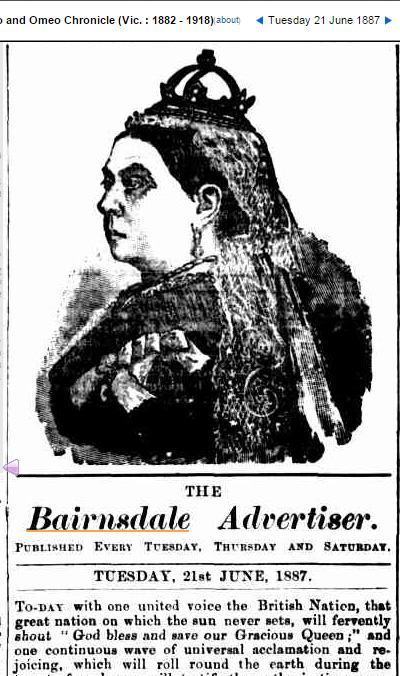
Queen Victoria's 50th Jubilee notice, from the Bairnsdale Shire in 1887.
The acknowldgement from the people of Bairnsdale to the Queen of the 21st June 1887, is quoted as
"To Her Most Gracious Majesty Victoria our Queen.
May it please your Majesty,
The President and Councillors of the Shire of Bairnsdale humbly beg to tender to you, for themselves and the residents of the municipal district, their sincere congratulations on the completion of the 50th year of your reign. And desire to give assurance of the continuance of their loyalty
and attachment to the Crown.
F. W. DREVERMANN, President ;
ROBERT COCHRANE, MICHAEL GOOLD, JOHN CALVERT, A. MACARTHUR, A. T. BUTTERRS, Wm SINCLAIR ROSS, JAS. HAY
SMITH, GEORGE TELFER, DANIEL SCOTT, HENRY H. SAINSBURY, WILLIAM HODGSON, Councillors ;
H. BREDT, Secretary. Bairnsdale, June 21st, 1887."
Hop grower and community minded local, Robert Cochrane, expanded his original involvement from 1886 as a Member of the Bairnsdale Horse Racing Club, and later became the Club's Vice President in 1891.
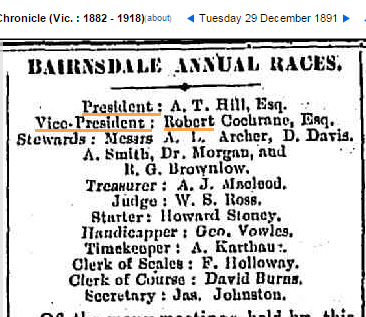
Bairnsdale Racing Club (horses) with Robert Cochrane as Vice President in 1891.
As fate can often dictate within a short passage of time, even in just one single year, a Pioneering family surviving natures elements living off the land and the seasons, such as the circumstances of Robert and Elizabeth Cochrane, life can take a complete turnaround, in a very short period of time. The year of 1893 was one that seemed to commence and continue as expected, with the Cochranes selling excess fertilizer, Robert heavily involved in important matters as the Shire President, and the opening of the important Mitchell River Weir, yet this particular year ended in a very abrupt change, in many ways.
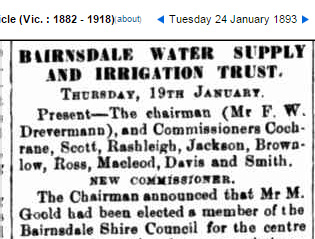
Commissioner Robert Cochane of the Bairnsdale Water Supply and Irrigation Trust in 1893.
The 24th of January of 1893 finds Robert Cochrane in the position of one of about 19 Commissioners of the Bairnsdale Water Supply and Irrigation Trust, who are in the final stages of overseeing the building of the very innovative Mitchell River Weir, designed to help control local floodwaters, and assist in water storage for the township of Bairnsdale.
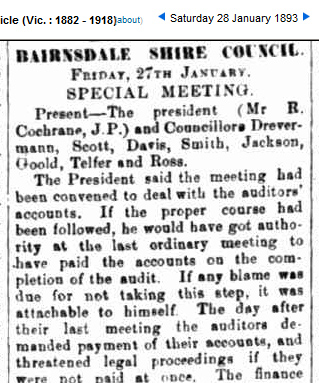
Four days later, the local newspaper confirms our Robert Cochrane is a Justice of the Peace and the Bairnsdale Shire President, who acknowledges there was an accountability problem paying outstanding Shire accounts, in conjunction with the auditors reports and requirements. A later newspaper cutting advises Robert Cochrane served on the Bairnsdale Shire till his allotted time as a Councillor officially ended in August 1894, as formally described in the Bairnsdale Advertiser and Tambo and Omeo Chronicle newspaper, quoted as "caused by the retirement on account of the effluxion of time of Councillor Robert Cochrane".
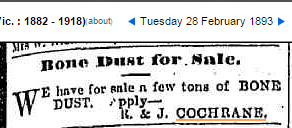
Feb 28th of 1893 finds "R & J Cochrane" selling a ton of surplus "Bone Dust" to help make ends meet financially - ie. todays equivelant of Blood and Bone fertilizer. Other advertisments outline this fertilizer was targeted for sale by the cochrane Brothers to Farmers, Hopgrowers, and gardeners, for between £5 (pounds) 15s (shillings) and £6 (pounds) 15s (shillings) according to quality. In modern terms, that's the equivelant of between $13 and $16 per ton.
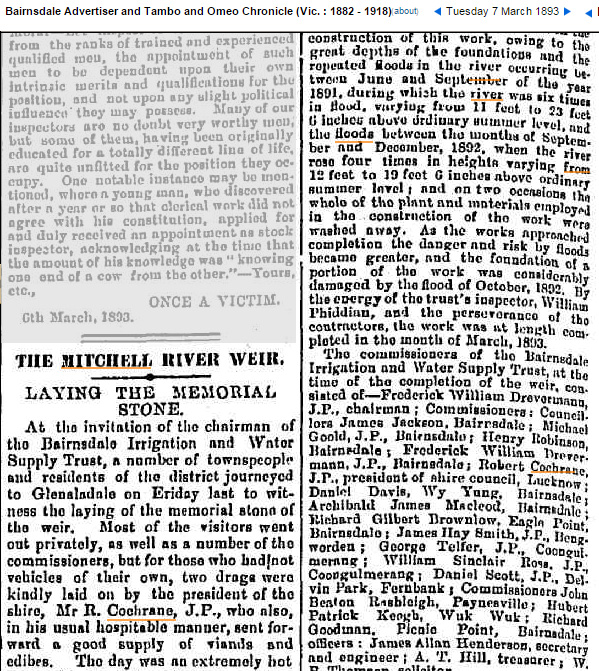
This article of the 7th of March 1893, describes Robert Cochrane as Bairnsdale Shire President, Justice of the Peace, and Irrigation and Water Supply Trust Commissioner, who make a substantial contribution of transport (river drags) and food (edibles), towards the success of the launching ceremony of the Mitchell River Weir Memorial Stone on the 7th March 1893.
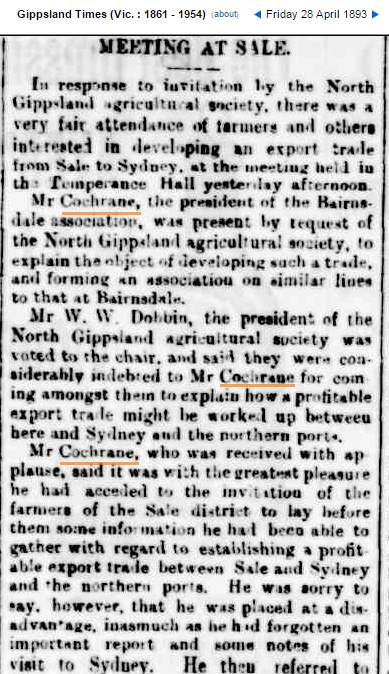
This newspaper report of the 28th of April in 1893, indicates Robert Cochrane is a very busy Justice of the Peace in the Bairnsdale Court House, and a dedicated Shire President, who recently returned from a very long trip to Sydney, investigating potential export trade and business on behalf of the many local growers & producers of the Bairnsdale Shire.
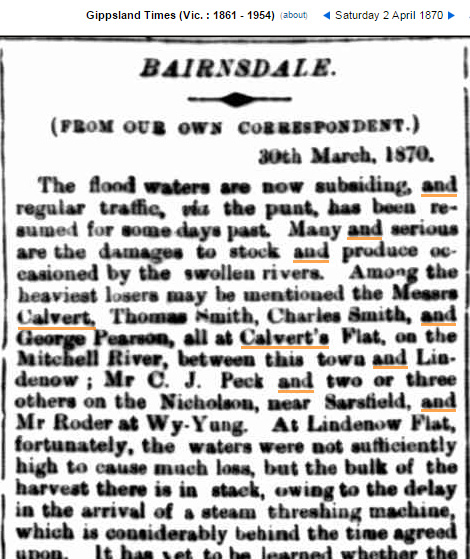
Newspaper cutting of the 1870 floods on William Calvert's land on the Mitchell River Flats in 1870.
On one hand, the Cochrane's choice of land selection on the Mitchell River was logical and understandable, as the flats of this area are still renowned as having high amounts of nutrients in the soil, conducive to growing many types of crops, including Hops the Cochrane bros specialised in. On the other hand, the risks from long standing record of major floods of the Mitchell river were well known, as experienced by their Calvert relatives, back as early as April of 1870.
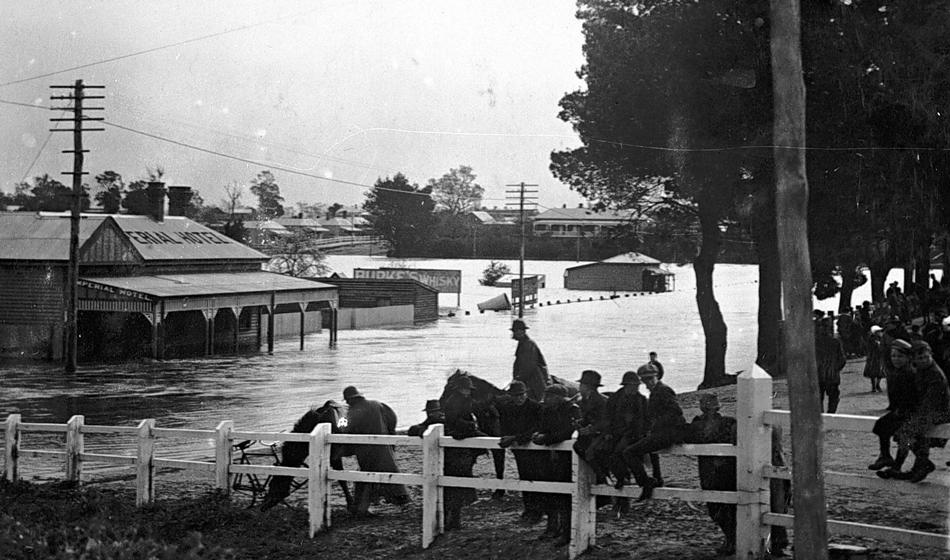
Typical early flood scenes on the Mitchell River at Bairnsdale - Courtesy Museum Victoria.
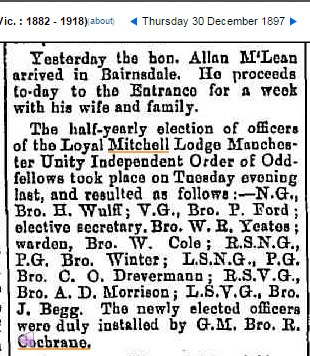
Mitchell Lodge Manchester Unity Independent Order of Oddfellows - 1897 G.M. Robert Cochrane (General Manager).
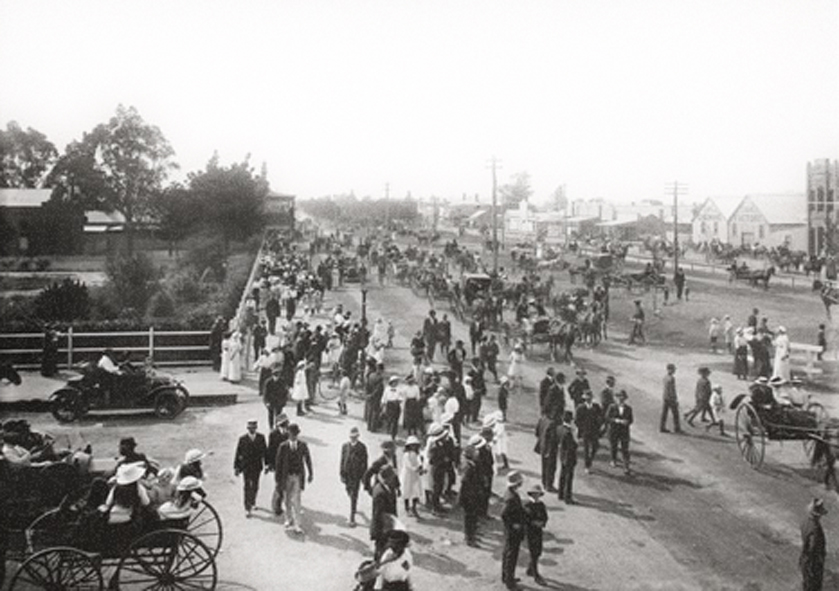
Main Street of Bairnsdale Circa 1910s - Courtesy reimaginingbairnsdale.com.
Newspaper cuttings of 1894 as above, indicate the Mitchell River floods of Dec 1893 and Jan 1894 were absolutely devastating for this Cochrane family, leaving them insolvent. In other words, they did not have enough cash to repair the floods damage to their crops and property, as well as keep enough credit in the bank to pay their business accounts. The devastation to their crops, and subsequent damage costs, took another 24 years, till 1918, for them to pay all the resultant debts, to attain a formal "insolvency discharge".

Insolvency discharge in 1918 of R & J Cochrane - they paid the business debts the year Elizabeth passed away.
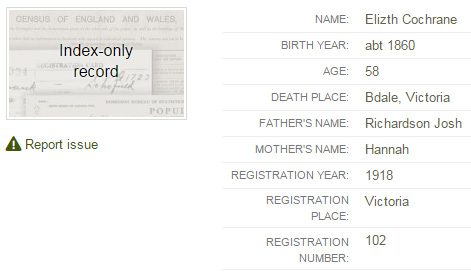
Death record from ancestry.com for Robert Cochrane's wife, Elizabeth Cochrane nee Richardson, daughter of John Richardson and Hannah Allison from Alston Cumberland, who died in Bairnsdale in 1918.
Death Record details
Elizabeth Cochrane Death Age: 57
Late Residence: East Bairnsdale
Burial Date: 16 Mar 1918 Bairnsdale Cemetery
Section: Methodist
Occupation: Home Duties
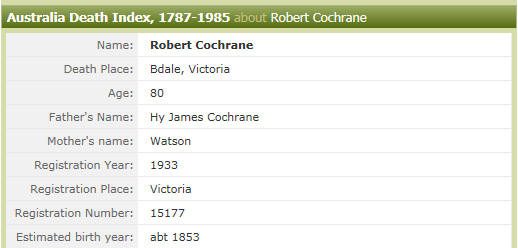
Death record of Robert Cochrane Esquire, second son of Henry James Cochrane and Elizabeth Caroline Watson of Bamburgh, U.K.
For further information on the children of the Gen 2 Cochrane family above please visit Ancestry.com records of
Robert Cochrane born 1778 in Eglington and his wife Jane Tully
or download Cochrane Family History PDF document, with thanks to Jenny Hawkins.
A special page and tribute to Fred Walters, international performer known as the Blue Man, whose son Granville Charles Berkley Walters married Robert Cochrane's grand daughter Jean Ann Cochrane, available for review here, at fred_walters_family_research.html

Back to Site Index.

Background into Lead Ore Mining in Northern U.K.

Background into the Gold Rush days near Ballarat Victoria.

From Joseph Richardson born 1721 at Alston, U.K.

From John Armstrong born in 1705, Haltwhistle U.K.

From Thomas Bell born 1806 of Allendale, U.K.

From James Broadwood born 1796 of Northumberland, U.K.

From William Calvert born 1791 at Kirkhaugh, U.K.

From John Clementson born 1692 in Garrigill, U.K.

From Robert Cochrane born 1778 in Eglington, U.K.

From William Coulson born 1760 in Cumberland, U.K.

From Edward Hewitson born 1794 in Kirk Linton, U.K.

From John Liddell born circa 1780 in Ninebanks, U.K.

From Joseph Parker born 1810 at Allendale, U.K.

From Nicholas Vipond born 1655 in Alston, U.K.
Email here re enquiries, corrections, or input to this site